TABLEAU
COOKING FOR WELLNESS
DINING HOT SPOTS
WHAT’S NEW FOR SPRING
SPRING CLEANING IDEAS
THE BLOOM ISSUE:
WILDFLOWER SPOTTING, PERSONAL GROWTH, NATIVE GARDENS AND MORE!



COOKING FOR WELLNESS
DINING HOT SPOTS
WHAT’S NEW FOR SPRING
SPRING CLEANING IDEAS
THE BLOOM ISSUE:
WILDFLOWER SPOTTING, PERSONAL GROWTH, NATIVE GARDENS AND MORE!


This is absolutely my favorite time of year, when the world feels fresh and full of possibility. Blue skies and puffy white clouds, rain showers that leave behind rainbows, green hillsides, wildflowers and beautiful garden blooms. The promise of summer just around the corner.
And, of course, spring is about growth. And this edition of our wonderful magazine celebrates growth in so many forms. In these beautiful virtual pages you’ll find:
• Personal growth — Bridget Belden provides her relatable perspective on development with some tips to get you on a positive path to insight and self-care
• Gardening — Alyssa Hamilton shares her journey in starting a native garden
• Fresh food — Anita Lau reviews the garden-to-table restaurant 608 Dahlia, and Amy Senk offers a behind-the-scenes look at a healthy new cookbook that benefits a local charity
• Spring cleaning — Allison Hata’s feature helps us clean up, clean out and freshen up our homes
• Wildflower spotting — Sara Hall’s guide leads you to the region’s best wild blooms
We hope you enjoy this special issue and that you’ll share your favorite stories with a friend or two. Happy spring to you from the Tableau Magazine family!
With gratitude,
Carrie Freitascarrie@kitchentablepr.com
@tableauofficial
@tableauoc

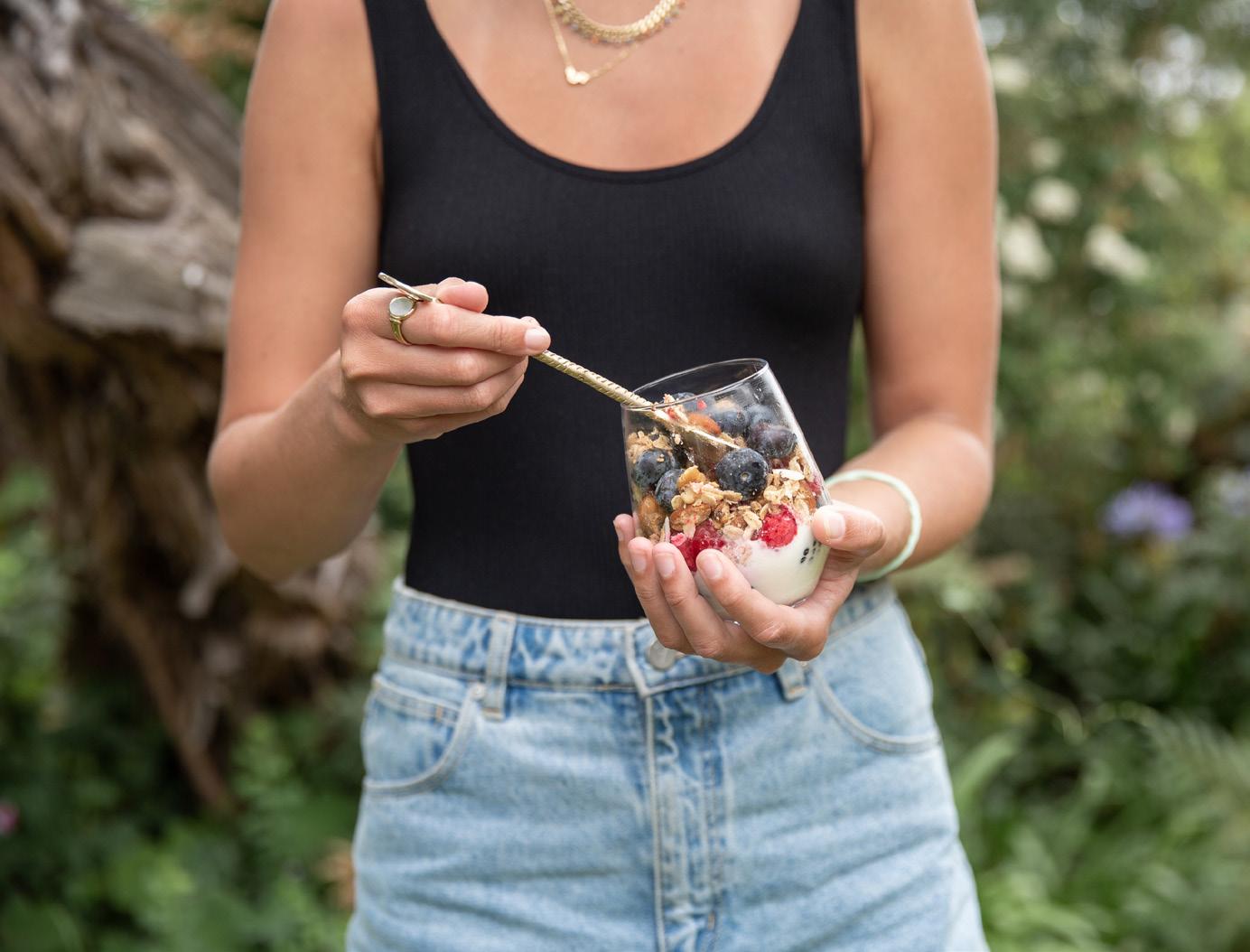



Bridget Belden
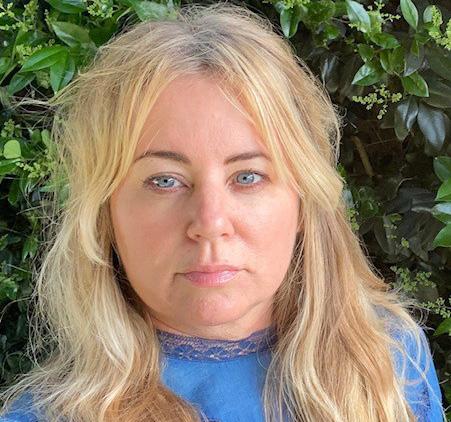
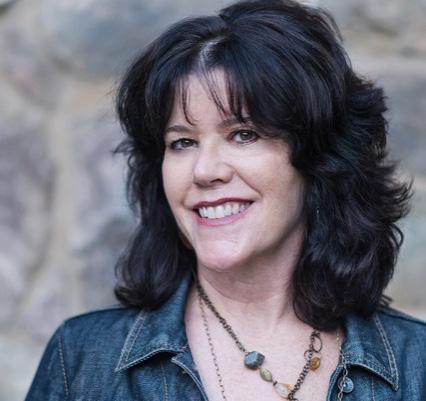
Bridget Belden is Founder and CEO of Magenta Consulting, a coaching organization providing world class tools to empower women to discover who they are beyond being a mom. After Bridget’s own struggles to find fulfillment as a mom with young kids, she started Magenta Consulting to help others on the same journey. She lives in Orange County with her husband of 30 years, Charlie and their dog Max. She loves travelling, spending time with friends and family, and will rarely pass up the opportunity for a good meal and a nice bottle of wine.
Sara Hall

Sara has nearly 14 years of experience at several daily and weekly newspapers, including The Record Searchlight in Redding, The Daily Advocate in Greenville, Ohio, the Newport Beach Independent, and most recently at Stu News Newport and Stu News Laguna. Her work has included photography, writing, design and layout. In her free time, she enjoys hiking, backpacking, traveling, and spending time with her husband and pets.
Alyssa Hamilton

Alyssa is a lifelong Southern California resident. She has been writing professionally for over 20 years, primarily for health websites and magazines. She is an MFA candidate at Sierra Nevada University and is currently working on a novel. She enjoys biohacking and preventative health practices, full soil immersion in her native garden, and spending time with her two teenage sons and their black Lab named Bear.
Sammy Harris
Sammy is a Public Relations student and soon-to-be graduate at The University of Oregon. She has explored social media management as well as personal and professional writing particularly in the lifestyle/wellness community. Originally from Southern California, she typically finds herself on the beach, searching for the best local Americano, or planning her next travel adventure to chase the sun alongside her family and friends.
Allison Hata
Allison Hata is a freelance writer and editor based in Southern California. She lives and breathes OC, covering food, style, design and culture around town for over a decade. A former editor for Newport Beach Magazine, Allison is passionate about telling stories that capture the fascinating people and places that shape her community. Her work has appeared locally in Modern Luxury, Pelican Hill Magazine, Design OC and more.
Anita Lau
Anita has been a food writer for almost 30 years, first in Asia, Australia and the Bay Area, before settling in Orange County, 15 years ago. Besides her blog, "diary of a Mad Hungry Woman", Anita was also an International Producer for Netflix's The Final Table, and has judged numerous cooking competitions, including Gordon Ramsay's, Hell's Kitchen. Locally, she has contributed to various publications, including Riviera, Laguna Beach and Orange Coast magazines. She is hugely passionate about giving back, and thoroughly enjoys volunteering, especially, involving underserved women and children.
Amy Senk
Amy is a CDM resident and a graduate of the Missouri School of Journalism. She has worked at the Kansas City Times, Kansas City Star, Contra Costa Times, Coast Kids and Coast Magazines, and is a regular contributor to StuNews Newport. A recent empty nester, she spends her free time with her husband and planning elaborate imaginary vacations.

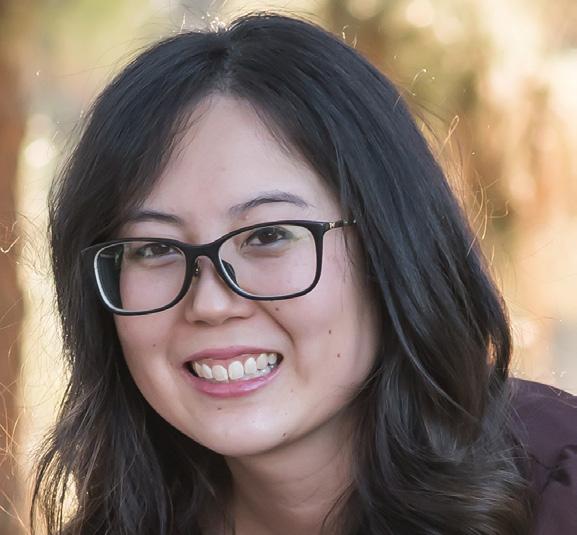
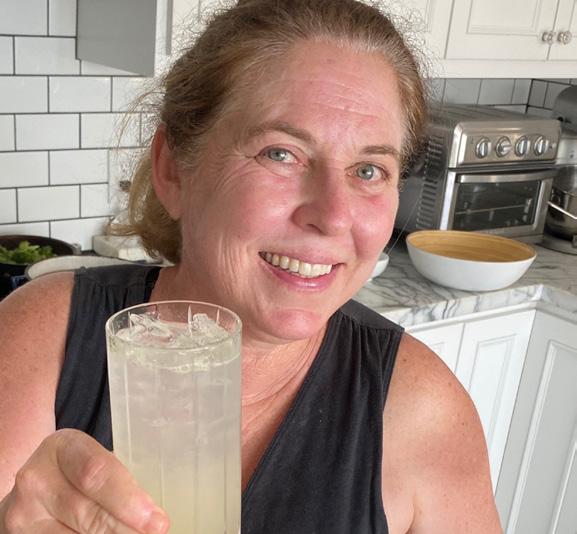 Miki Akil
Simone Brown
Kristen Cagatao
Lee Vujnovich
Miki Akil
Simone Brown
Kristen Cagatao
Lee Vujnovich
Want to get your hands dirty? At The Ecology Center in San Juan Capistrano, this is definitely encouraged. All 28 acres are dedicated to the education, connection and experiences surrounding a more holistic agriculture, making it the ultimate spot to kickstart a healthier lifestyle. People of all ages are welcome on the regenerative organic farm, which offers a daily farm stand and programming that includes tours, sensory garden experiences for children, workshops and volunteer opportunities. This spring, join renowned chefs from across the country for a Community Table dinner at The Ecology Center. You’ll enjoy a familystyle feast featuring beautifully crafted, fresh dishes with ingredients straight from the farm. Visit the website for the latest event calendar and list of participating chefs. theecologycenter.org | IG: @theecologycenter
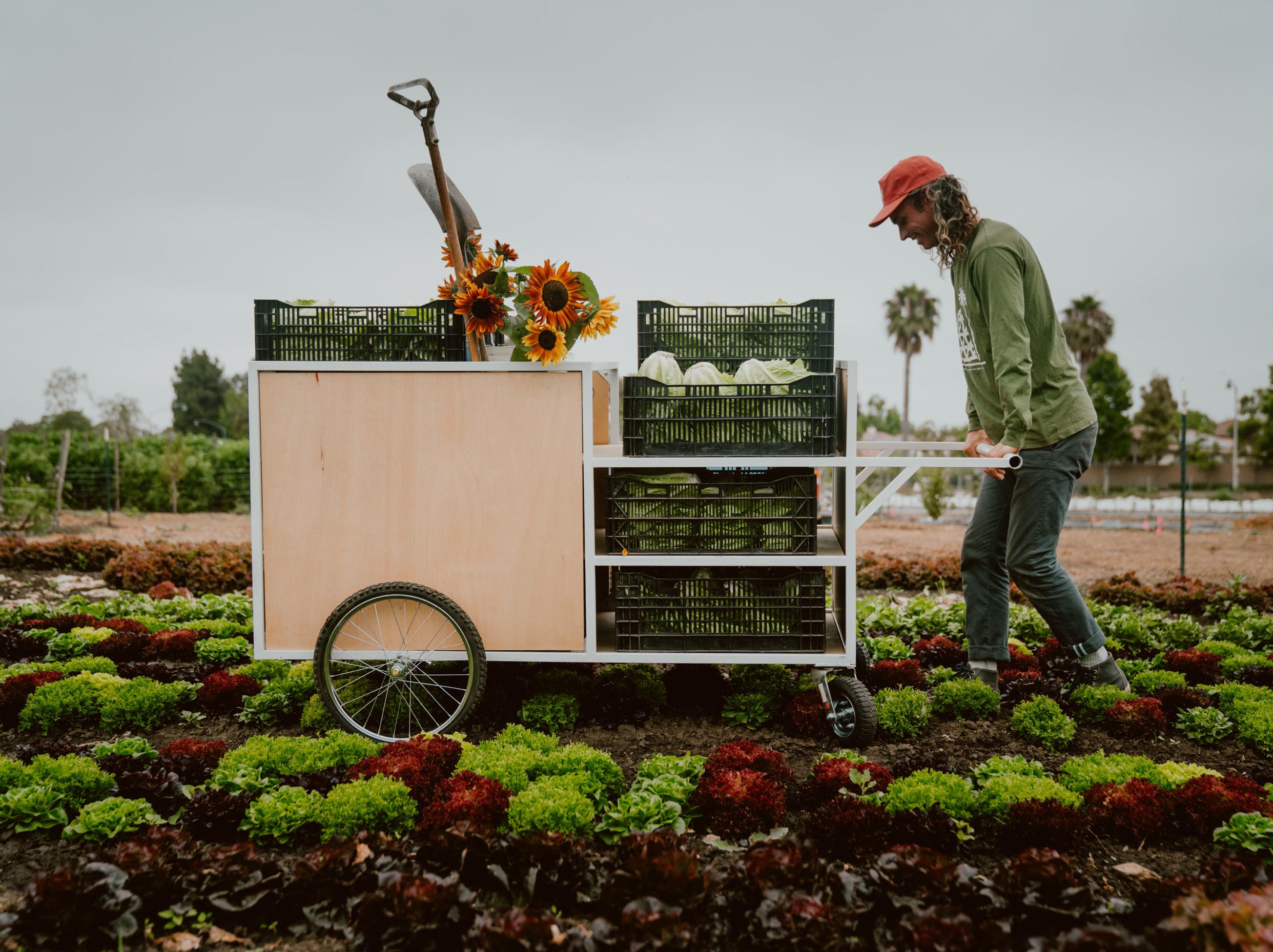 Photos courtesy of The Ecology Center in San Juan Capistrano, Circa Lighting, and Giana Bakery + Provisions
Photos courtesy of The Ecology Center in San Juan Capistrano, Circa Lighting, and Giana Bakery + Provisions

We could all use a little refresh of the spaces where we spend the most time — a change of environment is so powerful in boosting productivity and allowing room for imagination. Look to lights to make your aesthetic dreams come true, from playful sconces and table lamps to statement-making chandeliers. You’re encouraged to spark your creativity at Circa Lighting, which has a new Costa Mesa showroom filled with designer-curated collections of high-end products for residential and commercial spaces. If you’re not yet ready to commit to a specific feel, the showroom also offers a variety of inspiration spotlights featuring the company’s real-life clients. As the saying goes: Out with the old, in with the new. We don’t make the rules! circalighting.com | IG: @visualcomfort

Sister restaurant to Maison Café, Giana Bakery + Provisions found its home last year on PCH in Dana Point. Open daily, the coffee shop serves up European-style baked goods; for a sit-down meal, visit Tuesday through Saturday evenings to enjoy dishes such as fresh bucatini with a red wine Bolognese and pan-seared salmon with white bean ragu. A day menu is also available with breakfast and lunch options served until 3 p.m. No matter when you visit, expect a homestyle experience featuring organic and fresh ingredients that are locally sourced. Giana also has ample provisions of confections, Italian meats, cheeses and wines for guests to purchase and enjoy at home. The dinner experience is enough to make it worth a visit but leaving with fresh bread for the next morning makes it a place you’ll keep coming back to again and again. gianadanapoint.com | IG: @gianabakery
We’ve all had an event that caused us to lose sleep over florals, right? For your next special occasion, don’t settle for just any garden variety florist. Recently opened at The OC Mix in Costa Mesa, Hadley & Ren Floral Co. has perfected the botanical game, whether you’re looking for fresh, preserved or artificial blooms. In addition to her storefront, founder Cynthia Tran designs cherished memories for weddings and events with bespoke arrangements, bouquets, wreaths and more. Fair warning: Hadley & Ren creates moments that have a history of tears, so bring tissues as Cynthia transforms your memories from momentary to eternal. hadleyandren.com | IG: @shophadleyandren

There’s no better time to start collecting than the present. For some, it’s antiques; others love perfumes. For Kathryn Miller, it’s timeless jewelry — 14-karat and 18-karat gold and diamonds in particular. Under the brand Mama Bijoux, Kathryn has built a family business of crafting fine jewelry that ranges from custom birthstone designs to mom-and-babe sets. Based in Orange County, Mama Bijoux makes a case for investing in heirloom-worthy pieces that can be worn for generations. Each piece is meant to embody your personal style, so you can pop into the Costa Mesa atelier to browse, consider a permanent bracelet, or create your one-of-a-kind design with the help of Mama Bijoux herself. shopmamabijoux.com | IG: @mamabijoux

They’re beautiful, smell nice and taste good, too? If you ask Loria Stern from Eat Your Flowers, botanicals are definitely not limited to the garden. A floral artist and bakery owner, she is also a trendsetter known for creating beautiful, flower-pressed cookies. This skilled gardener plays off the natural allure of florals and showcases them in treats sold at her Los Angeles bakery. Decadent pies, allergen-friendly cookies, and everything in between can be found both in-store and online (yep, she ships nationwide). Lucky for us, this makes it too easy to add a memorable touch to any special occasion. This spring, you can make your own garden-inspired cookies at home with the release of her first cookbook, “Eat Your Flowers,” out on April 25. eatyourflowers.com | IG: @loriastern
 Photos courtesy of Hadley & Ren Floral Co., Blaire Going, Eat Your Flowers, Merricks Kitchen, and Margaret Bruton
Photos courtesy of Hadley & Ren Floral Co., Blaire Going, Eat Your Flowers, Merricks Kitchen, and Margaret Bruton
No need for the 16-hour flight: Merricks Kitchen brings the Australian experience directly to your table. Named for a seaside town in Melbourne, the company creates a nutrient-packed blend of gluten-free oats, nuts, seeds, and all-natural sweetness known as Brekky. Founder Sarah Tobin pays homage to her childhood with this breakfast blend, which began as a family recipe but has been refined with new ingredients like dried kiwifruit, cranberries and apricots. Great on yogurt, with a smoothie or on its own, it’s a great way to start a wholesome morning routine. Find this blend of Aussie-inspired, organic ingredients at boutique retailers throughout Newport Beach and Costa Mesa; a full list can be found on the company’s website. merrickskitchen.com | IG: @merrickskitchen
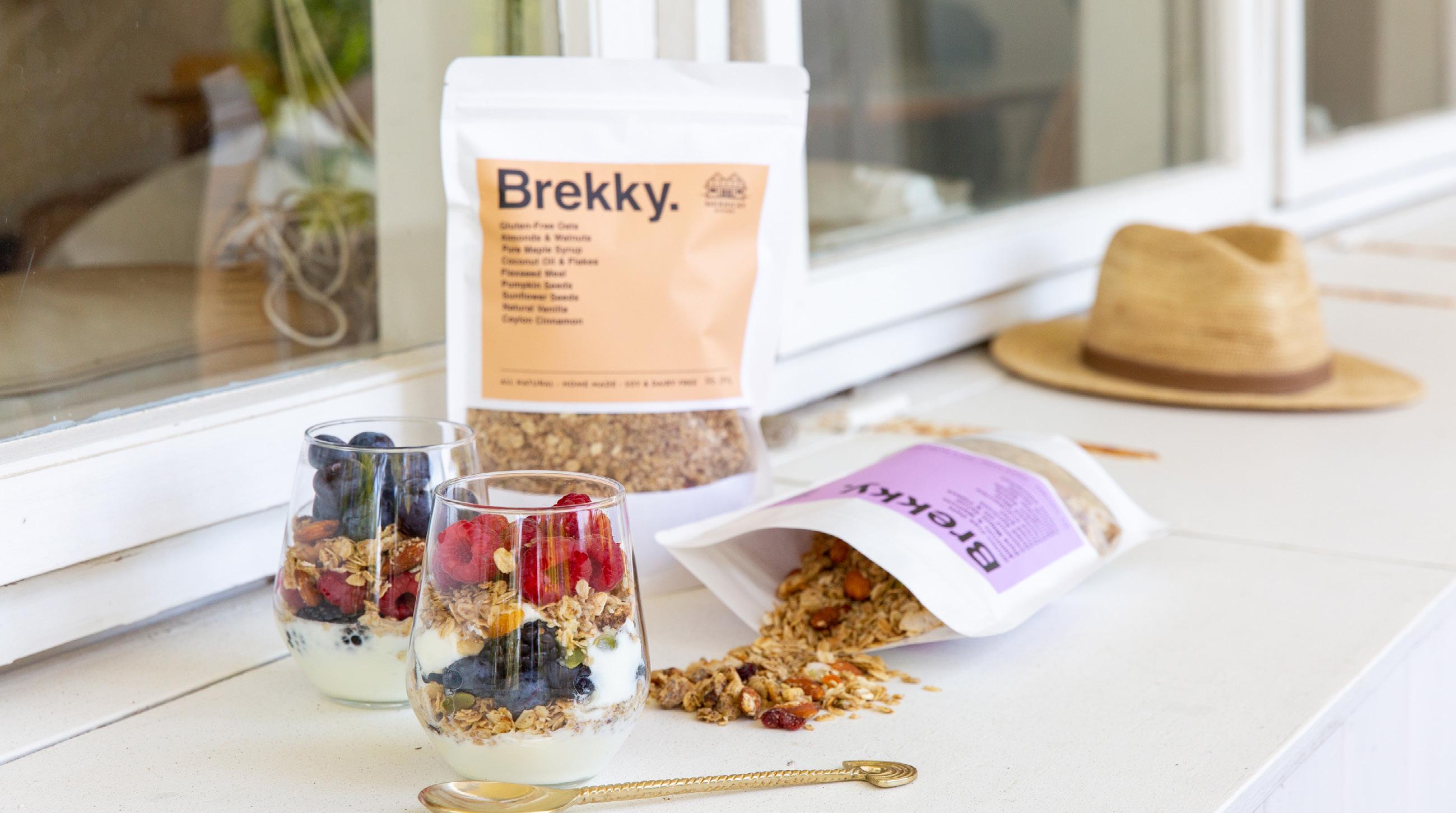
Behind the modern art movement, there are three unsung women who made prolific contributions to the genre. Now, for the first time in 50 years, the Bruton sisters are getting the attention they deserve, finding their rightfully earned spotlight at the UCI Jack and Shanaz Langson Institute and Museum of California Art. Margaret, Helen and Ester Bruton, born in the Golden State at the turn of the century, helped collectively advance California Modernism through their unexpected use of materials, themes and abstract ideas. Between the 1920s through the 1960s, they each experimented and pushed boundaries in their chosen mediums, including mosaics, prints, paintings and terrazzo. The exhibition offering a retrospective of their lives and work is on view through May 6. imca.uci.edu/exhibition/bruton-sisters | IG: @uciimca
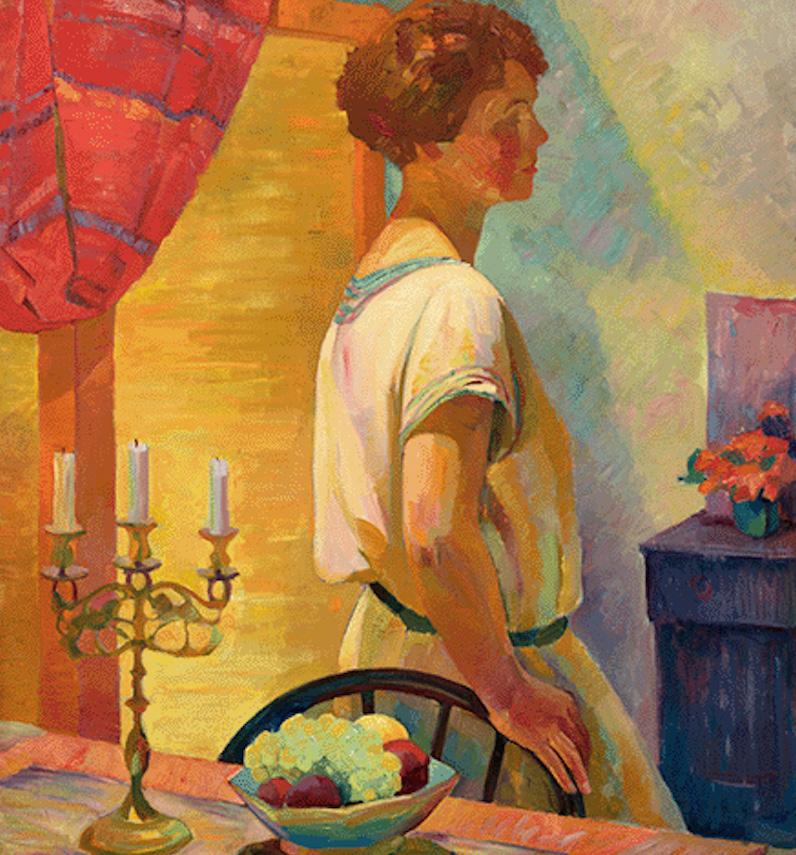
 By Amy Senk
By Amy Senk
The friendship between Audra Wilford and Anne Watson was inevitable, the universe throwing together two women who bonded over food, family and fighting for a loved one with cancer. Years later, their Fierce Foods work has culminated in the publication of an anti-cancer cookbook — a project that, like their friendship, was always meant to be.
“The Fierce Foods Kitchen: Healing Through Culinary Medicine” represents a decade’s worth of recipes, tips and principles culled from the Fierce Food Academy, a MaxLove Project initiative that uses cooking classes to help families bond while they learn about nutrition and cancer-fighting foods. Audra founded MaxLove Project in 2011 after her son, Max, was diagnosed with cancer. Each initiative and program support its mission to increase quality of life and reduce health risks for families surviving childhood cancer and related rare diseases.
Photos courtesy of Anne Watson“The concept of the Fierce Food Academy came from my own cooking with Max after he was diagnosed,” Audra says. “When I learned about the healing power of food, I started modifying his diet and learned how to make new recipes and … cook without added sugars.” Despite her culinary background, Audra had to do a deep dive to learn about therapeutic nutrition. She began creating recipes and sharing them with other parents of children with cancer.
“It started to organically grow, sharing the information and sharing my learning,” Audra says. “I was really struggling to modify food, yet I am culinary-trained. I knew how to correct something. I knew how to experiment. But for these other parents who don’t, this could be just enough to give up.”
Cooking classes began in early 2013 in a teaching kitchen at Saddleback College, and Audra continued to work with dietitians to formulate the tenets of the Fierce Foods philosophy. She asked questions like “What does an evidence-based, anti-inflammatory diet look like?” and “What is the data showing us about the relationship between nutrition, inflammation and cancer?” Clarifying conflicting information and advice that parents would find online also became a goal. She also began recruiting chefs to help create recipes and teach more classes. Eventually families began to ask, “Hey, when are you going to have a cookbook?”
The seed for a Fierce Food cookbook was planted but would ultimately need time to germinate. Meanwhile, food photographer Anne Watson had been hired by Sapphire Catering to cover MaxLove Project’s Farm to Fork dinners at Tanaka Farms. In 2019, Audra reached out to discuss the assignment with Anne, who had just learned that her husband had terminal cancer. A cordial professional relationship immediately became personal and intimate.
“I don’t know if serendipitous is the right word,” Anne says. “It just felt very meant-to-be.”
Audra agreed.
“Our first conversation opened the door to one of the most significant friendships of my life,” she says. “We are just soul-connected. We met at the right time. I can’t believe we didn’t meet before, sometimes. I feel like I’ve known her forever. She’s like a sister, a chosen sister.”
They teamed up again later the same year, when Audra put together a cookbook team that included Anne, along with chefs, dietitians and designers.
“We were so excited to make the first MaxLove cookbook,” Audra says. “Then Covid hit.”
With funding no longer available, the cookbook plans were shelved, but the cooking and teaching continued with online classes and information. The group continued to create, test and share recipes.

“We said, ‘Hey, we’re not going to stop. We’re going to push forward,’” Audra says. “Even though we don’t have the funding to create the cookbook or design the cookbook and do all of that, we’re going to keep pushing. And we survived Covid and came through it with a ton of tested recipes.”
Audra also reconnected with a professor at the Massachusetts College of Art and Design in Boston who had helped her with a curriculum guide for MaxLove Project’s hospital-based program in 2017. The professor asked if Audra had any new projects.
“You know what?” Audra told her. “We really want to make our cookbook. Would you be willing to design a cookbook?”
The professor agreed, so Audra brought her team together once again.
“Within six months, we had gathered all the food photography, all the recipes, all the nutrition data, all of the text for the book,” she says.
For Anne, the Covid pause gave her time to spend with her husband, who died in 2021. She also transitioned her career to be able to spend more time at home with her 9-year-old son. She remodeled her home to include a photography studio and began shooting food there instead of in the field in restaurant kitchens.
“It was ready to go when we started shooting the cookbook,” Anne says. “The chefs would make the recipes [and] send them over to me, I would test them and cook, style and shoot them right in my home.”
Along with Audra and Anne, cookbook contributors include chefs Andrew Johnson and Cathy McKnight; nutrition information and lesson author Alexia Hall; photographer Nicole Wilson; and editor Jordan Nishkian.
The book grew out of recipes taught to families with children fighting cancer, but this book is different from most cancer diet cookbooks, Audra says.
“I’ve purchased a lot of the anti-cancer books out there, and a lot are not accessible,” she says. Many have recipes for things like seared salmon with kombu broth — healthy, sure, but expensive and complicated, and not necessarily kid-friendly.
“And those are all of our parameters,” Audra adds. “We are looking at accessibility, affordability, tastiness, and then also our Fierce Foods criteria. In our recipes, you’re going to find very limited sweeteners. There will be dates, maple and honey, if there are any.”
The book is constructed to give home cooks flexibility when they are shopping for ingredients that may not be available or may cost more than their budget can accommodate.

“We focus on what is most important in this meal,” she says. “You’re getting a good amount of dietitianwritten information on cancer, which is amazing. And it’s family-friendly. “
The book includes sections for smoothies and condiments, as well as ideas for quick sauces that can liven up any veggie you happen to be serving. There are also soups and desserts, among other categories.
A favorite for both Anne and Audra is a fried rice recipe that uses a 50/50 blend of white rice and cauliflower rice. Anne serves it with the book’s Eggroll in a Bowl that features crunchy cabbage and lots of carrots. The rice-veggie mixture is a game changer, they both say.
“People are not talking about the value of what we call the 50/50 approach, which is what it looks like to add 50 percent cauliflower rice to your rice mixture,” Audra says. “The nutritional impact of that is tremendous.
“Same thing with potatoes, same thing with other high starchy, carb foods,” she continues. “You can add fiber and micronutrients to it, and you’ve got that more palatable flavor for families that is kind of changing their diets. … In the [anti-cancer cookbook] space, you usually get an all or nothing approach.”
Speaking from personal experience, Anne agrees that this is a cookbook every family can use.
“How we nourish our physical body affects our mental and our spiritual and emotional bodies,” she says.
Photos courtesy of Anne Watson 14“It’s completely interconnected, and I am so relieved that there is a cookbook out there like this now. It speaks directly to my firsthand experience of watching how these recipes literally prolonged my husband’s life. They gave him a matter of weeks to live when he was first diagnosed. And he lived 18 months, and every month was a total gift.”
The cookbook also can help families bond. Those who choose and prepare recipes as a team could also begin to build lifelong, healthy habits. Audra’s son, Max, who is almost 16, used to help her cook in the early Fierce Food days, and he remains very tuned in to his nutritional choices and what his body needs.
“A good amount of this is in his hands, and he will say, ‘Listen, I think I need this today. I’m wanting this in my diet today. I don’t want to eat that,’” Audra says. “If we’re going out somewhere, he will really look at the menu and consider it. We don’t tell him what to do.”
The cookbook officially launched at a party on Feb. 26
at the Fierce Foods Academy and is available for sale on the MaxLove Project website. The first printing is limited, but Audra says she hopes to see future print runs and eventually availability on sites like Amazon and Barnes & Noble.
“This book really represents well over 10 years of the Fierce Foods Academy,” she says. “Our journey started with the food before we started teaching it.”

The book also marks a milestone in the history of MaxLove Project.
“It can be hard to see and feel and understand what MaxLove does if you’re not in the community seeing it,” Audra says. “It can be hard to tell the story and show people the power of what it means to support MaxLove Project. It’s one thing to say, ‘Hey, support cancer research because we hope we might find a cure.’ People get what that is. They don’t get what it means to support quality of life care for families who need it the most. And this cookbook provides us with something tangible. You can hold it. It has power.”
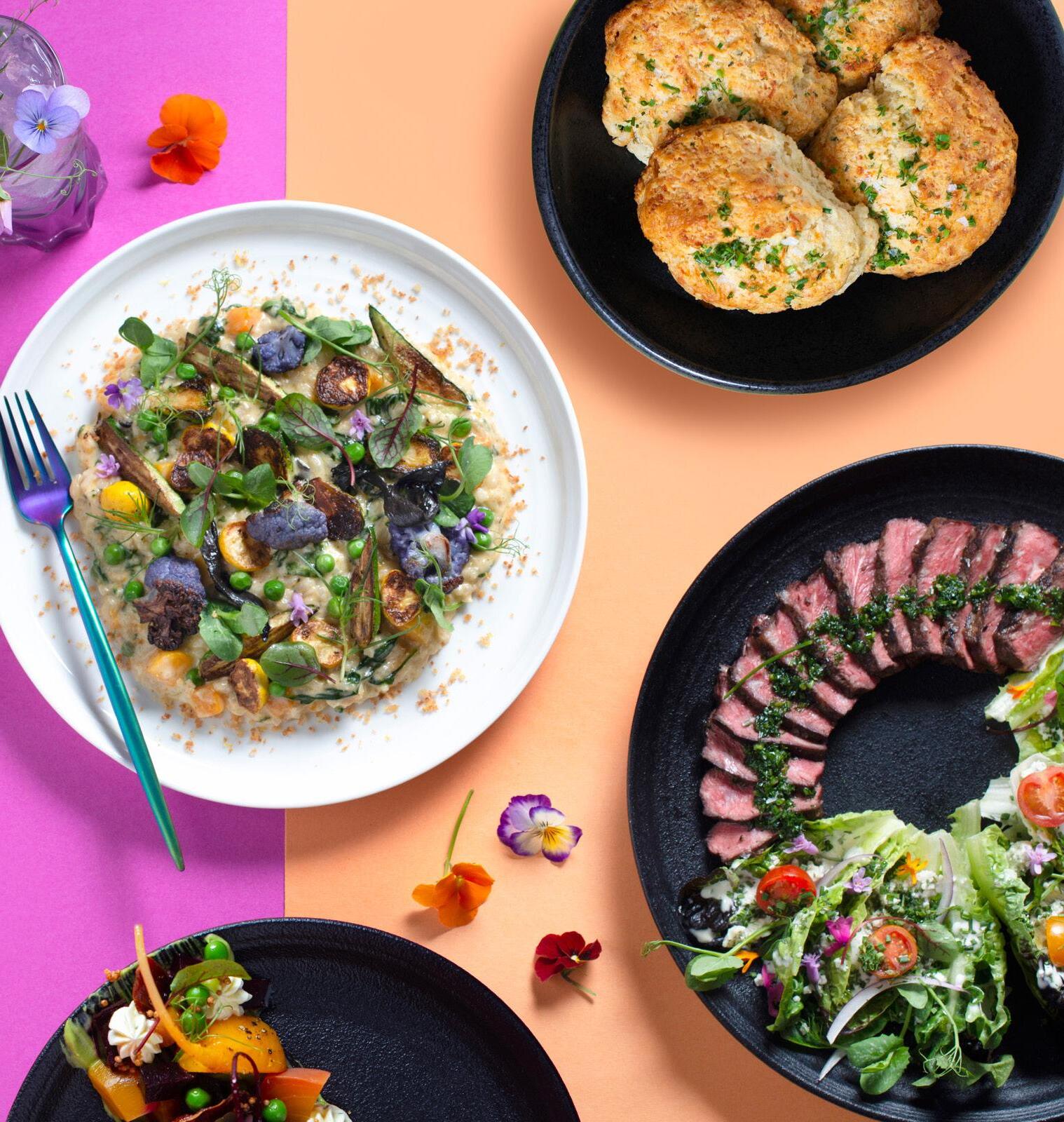
Nestled along PCH in Corona del Mar is Sherman Library & Gardens, founded in 1966 by Arnold D. Haskell, a successful businessman who was deeply passionate about education and gardens. After purchasing the beautiful cultural center in the 1950s, he had another wing added to the property in 1956 and started landscaping the surrounding area. Named after his mentor, Moses H. Sherman, this oasis hidden away behind brick walls is now home to a display of fantastic gardens and a research library with collections related to the history of the Pacific Southwest.
If you’re lucky, you might be greeted at the entrance booth by Julius Caesar, Sherman Library & Gardens’ resident cat. There is a $5 entry fee for visitors, which goes toward the maintenance and upkeep of the grounds. (If you’ve ever visited a botanical garden, you’ll know how tranquil and peaceful they are — it is no different here.)
Visiting this sanctuary is a relaxing and serene experience, but the best part is sitting down to a leisurely lunch at 608 Dahlia, the restaurant situated within the gardens. Surrounded by flora, the restaurant offers a menu that goes hand in hand with its environment. While there is indoor seating, it is best to snag one of the tables on the patio in order to experience garden dining to its fullest. There is nothing more pleasant than the panoramic views of the Central Garden, watching all the visitors meander around, taking in the splendor of spring, and relaxing with the sounds of nature and water splashing in the nearby fountain.
608 Dahlia Executive Chef Jessica Roy has a fresh, interpretative style enhanced by daily pickings from the gardens and local farms. Her menu is dotted with compelling seasonal offerings, highlighting ingredients at their peak. In her picturesque creations, expect to find striking edible blooms and herbs right from the Sherman grounds.

Having worked in some of the best kitchens in the country, including the Michelin-starred Alinea in Chicago, chef Jessica’s talent and passion are clear the moment dishes start hitting the table. How many times have you encountered a dish where it is visually pleasing, but does not live up to expectations upon the first bite? Here, each plate is a vibrant palette of colors, and the aesthetics and flavors are perfectly in sync. Dishes are thoughtfully curated, allowing the star ingredient to shine while supporting flavors do their job without ever overpowering.
While small-batch buttermilk chive and gruyere biscuits may seem too long to wait for — they can take up to 25 minutes — don’t let that dissuade you. It is absolutely worth the wait. From a recipe handed down from chef Jessica’s grandmother, these madeto-order biscuits arrive tucked in a basket and scorching to the touch. Impatient hands might try to

grab one right away, but they are too hot to handle. Break off a piece and slather with either whipped butter or orange blossom honey. The prominent flavor of aged French gruyere permeates; pair each morsel with a different condiment to generate a new experience with every bite.
Even though it might be tempting to continue noshing on those delectable biscuits, control that impulse — you can always take them home to enjoy. You don’t want to fill up before all the other marvelous menu items ahead, like heirloom garden beets, a gluten-free offering of sweet beet cubes paired with seasonal orange, local avocado, picked garden leaves, farmers market watermelon radish, dollops of whipped herb goat cheese, puffed sorghum, and a drizzle of balsamic reduction. If one could describe a season in a bite, this is absolutely spring! It’s the epitome of California cuisine.
For entrees, there are options to satiate any appetite. Being partial to fish, crispy trout was an obvious choice. Beautiful fork-tender trout is served
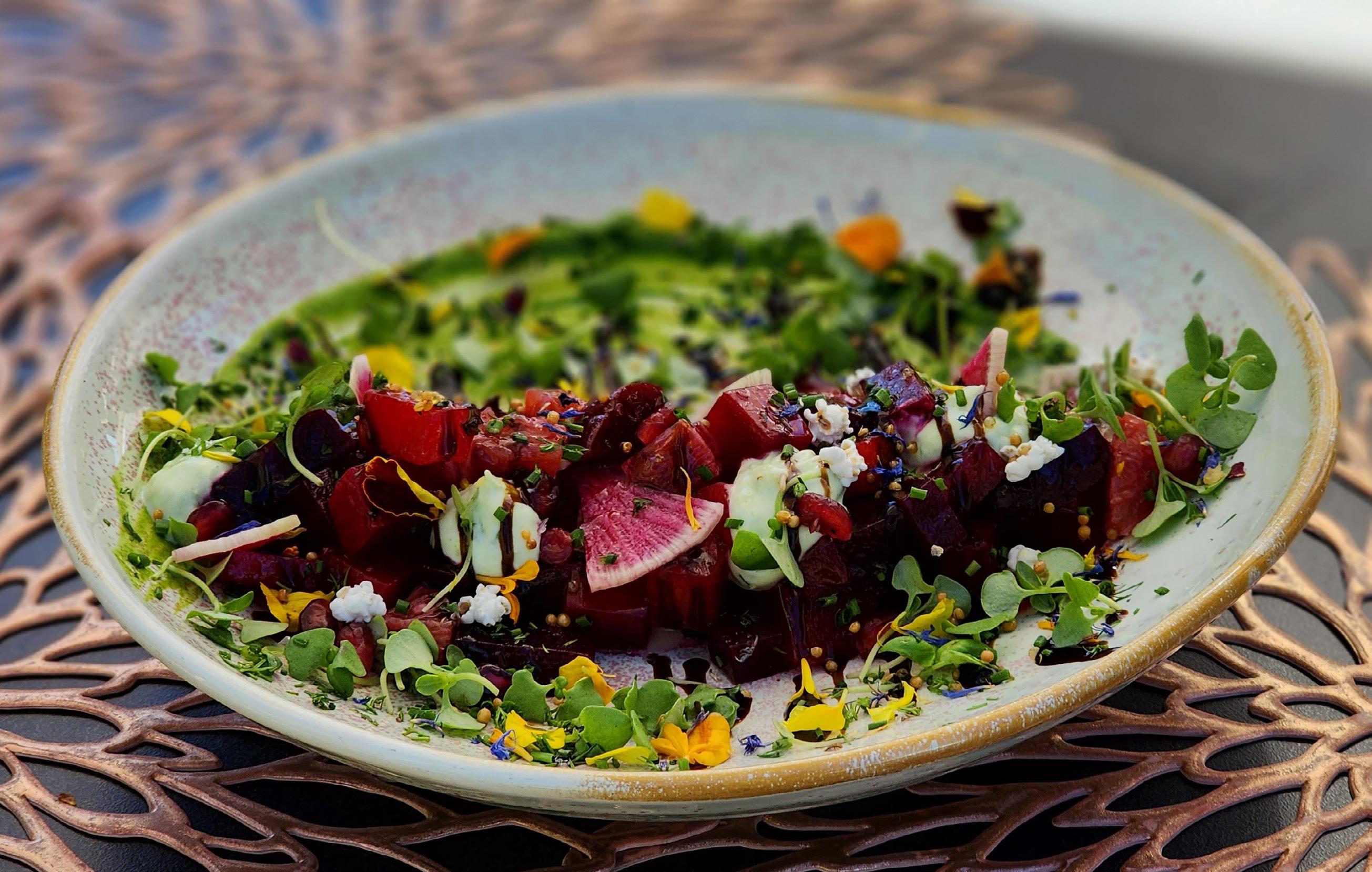
alongside accoutrements of whipped basil potato and a medley of beautiful seasonal farmers market vegetables, including Thumbelina carrots tied together with a toasted almond butter herb sauce.
If you are a fan of salmon, try the pan-seared option for a perfectly executed piece of fish atop a silky citrus emulsion, served with braised lentils and a melange of petite farmers market vegetables such as haricot verts and courgettes. The sprinkling of pomegranate seeds not only adds a splash of color to the mix, but also a pop of texture and sweetness.
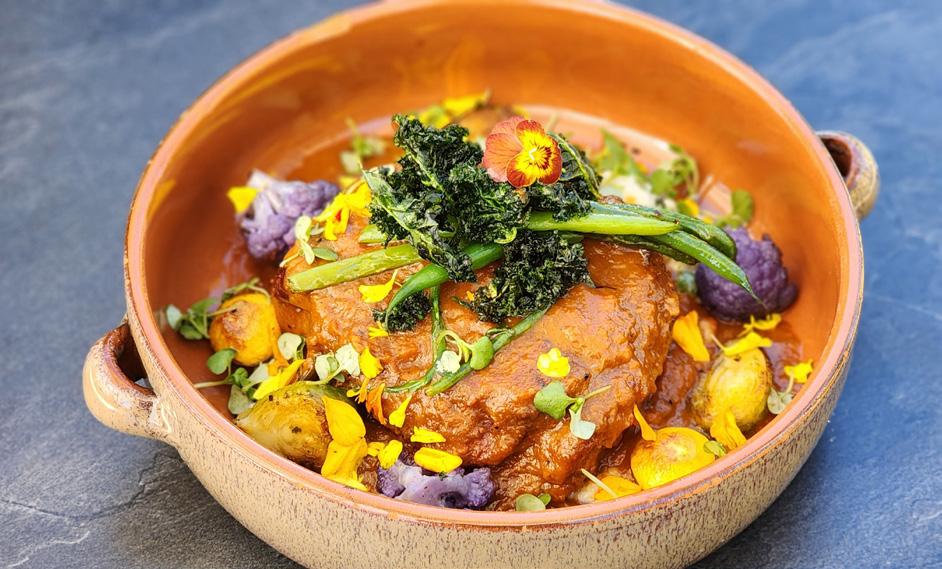 Photos courtesy of 608 Dahlia 18
Photos courtesy of 608 Dahlia 18
On the day of our visit, veal osso buco was offered as a special of the day. The succulent veal was rich and lavish, melting in our mouths with a bed of luscious pea and asparagus risotto beneath. Of course, every dish at 608 Dahlia features some sort of seasonal vegetables, and here, bright purple cauliflower
makes its striking presence. The crispy kale garnish was a fantastic touch, adding an element of textural contrast to the dish.
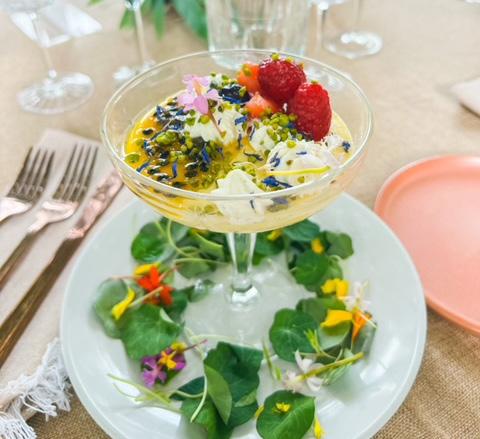
Leave some room for dessert because, well, you must! Spanish Basque cheesecake was creamy and luscious, topped with fresh marinated berries and whipped cream. Chocolate lovers will marvel at the decadent house-made flourless torte; it’s rich like ganache and oh so sinful, but truly magnificent.

Whether it’s before or after lunch, make a day of your visit by spending some time traversing Sherman Library & Gardens. You can take in the splendor of the beautiful space and relish in the best seasonal garden-to-table cuisine Orange County has to offer.
608dahlia.com | IG: @608dahlia
608 Dahlia is open for lunch Wednesday through Sunday from 11 a.m. to 2 p.m. There is a $5 admission fee to the gardens for non-members when dining at the restaurant. Reservations are highly recommended.
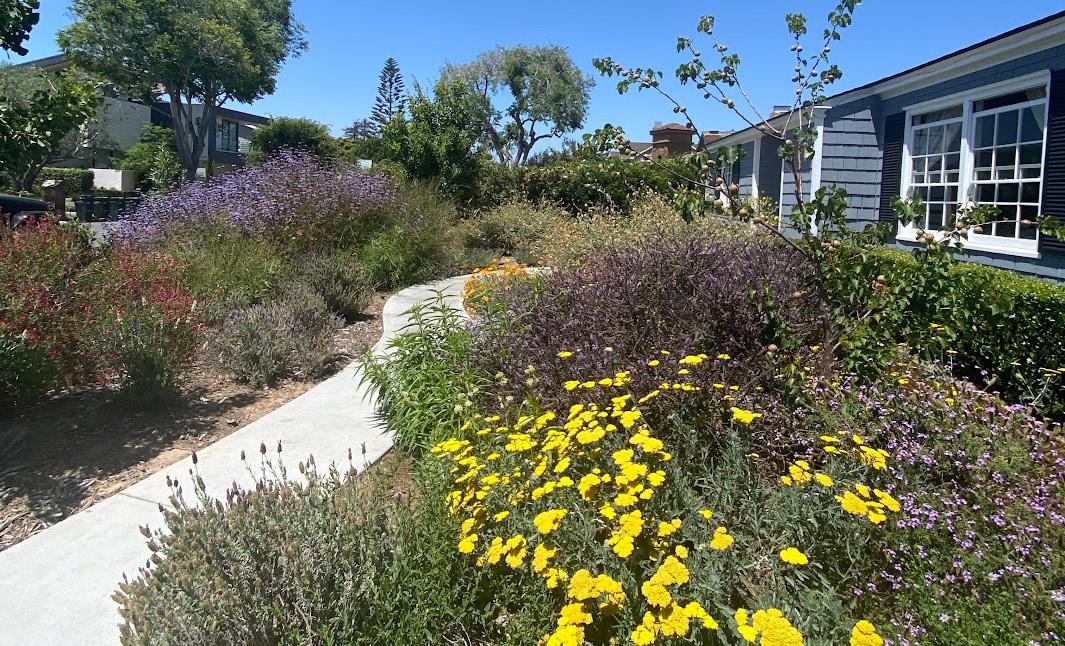 By Alyssa Swanson Hamilton
By Alyssa Swanson Hamilton
When some people think of native gardens in the Golden State, a tidy symmetrical array of cacti and succulents and rock borders might come to mind.
Isn’t California a desert, after all? Don’t we need plants that require almost no water? The truth is — although it’s home to some beautiful deserts, including the majestic Mojave — Southern California is actually considered a Mediterranean-type climate, with hot, dry summers and cool, wet winters. Los Angeles is part of one of the most diverse (and one of the most threatened) ecosystems on the planet: the California Floristic Province that stretches from Baja to southern Oregon, with 8,000 species of plants, nearly half of which are found nowhere else on Earth. But with increased development, the amount of land covered by these unique native plants has diminished by 70 percent.
Cactus gardens, or xeriscapes, are wonderful for desert climes, but they offer no forage, shelter or shade for our native birds, insects, lizards and other creatures that call Southern California home. Similarly, non-native decorative lawns, trees and flowers that originated outside of this part of the country, or outside the U.S. altogether, are not suited to support our local fauna, including pollinators. Both suburban and urban landscapes often fail to take into consideration our non-human neighbors. Without pollinators, we would lose almost all of our food crops. We have forgotten our interdependence.
Lawns, if you think about it, also don’t make a lot of sense here. They need a huge amount of water and fertilizer, which creates toxic runoff that goes right to our oceans and waterways. Their root systems are shallow and don’t enrich the soil with diverse microbes or prevent erosion, and they don’t feed or shelter local fauna. We have been conditioned to consider them stately and elegant, but what if we started looking at the concept of beauty with new eyes? What if we embraced nature’s own wild designs?
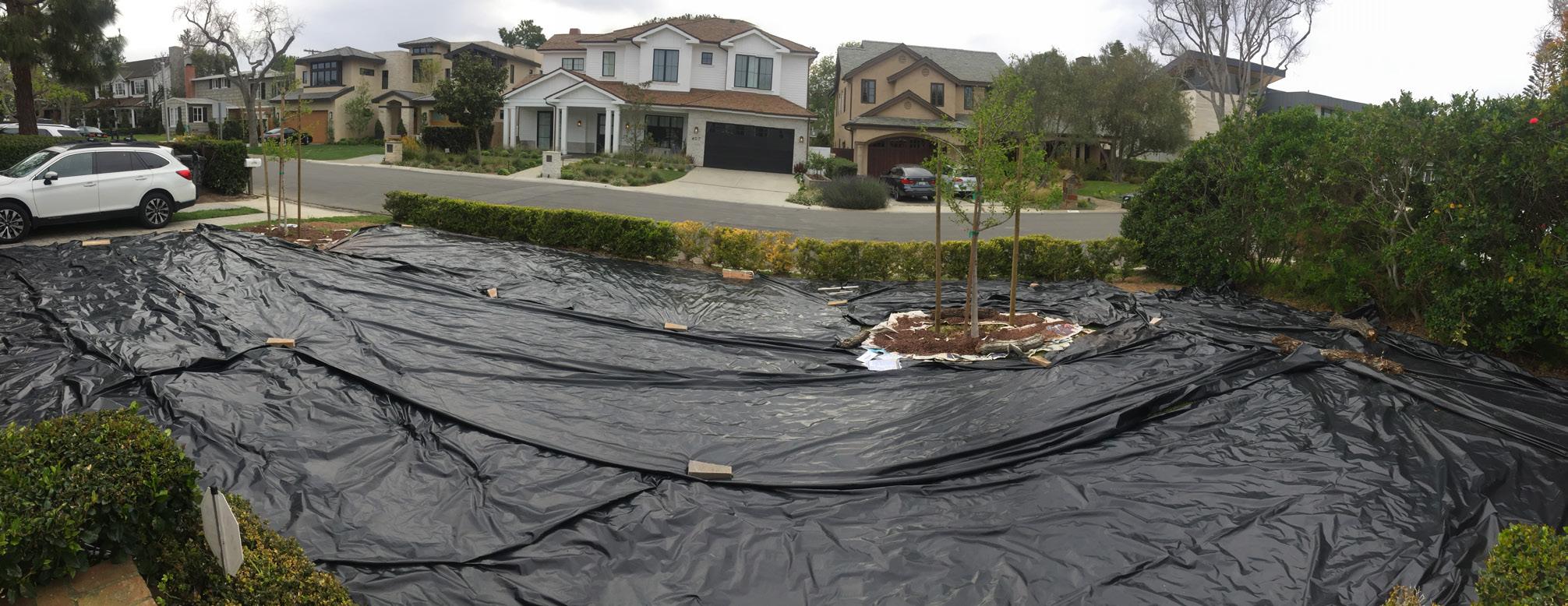
Planting a native garden, whether in your yard or as a container garden on a patio, supports local flora and fauna while also conserving water and providing major curb appeal. These plants require no fertilizer or herbicides — just a little mulch around them –— and very little water once they are settled. Native plants and trees are rich in color and texture, and every bit as beautiful as a structured English garden or a row of exotic rose bushes. Once established, many native
plants will re-seed on their own each spring, and those that go dormant in the winter will bloom back to life every year. Flowering varieties such as asters, beach daisies and coastal strawberry spread out over several feet, and native narrowleaf milkweed (the sole food of the monarch butterfly]) will happily take over patches of your garden with no assistance. Indian mallow, rose yarrow, Baja bush snapdragon (a hummingbird favorite) and autumn sage offer forage for local birds and butterflies. Want to see happy bees? Plant lavender. Many of these plants are also edible for humans, which is a great bonus. My personal experience with native gardening started in 2018, after I moved back into my old house in Newport Beach after a marital separation. The front yard was in poor shape. The St. Augustine grass was tough and hearty, but not pretty. The willow tree was dying because I had, in ignorance, planted it far from a water source. The eucalyptus looked like it might drop a limb on a car any moment, and the cityplanted elms were sad and sickly. I had read that I could get a rebate from the city if I took out my lawn and created a drought-tolerant landscape. It felt like a satisfying act of rebellion, to tear down the old and bring in something unexpected to my conservative neighborhood.
The trees came out first, over a series of months. I put in two city-approved and funded ginkgo biloba trees — not native, but drought-tolerant, and they feature medicinal leaves that can be made into tea. Finally, it was time to kill my lawn. I laid down sections of cardboard and unfurled long sheets of black plastic
to cover the front yard. I elected not to use Roundup or any other herbicides, since the potential for groundwater contamination and harm to beneficial insects wasn’t worth it. Do it in warm weather so the plastic fries your lawn over a period of a few months, as it takes patience and a willingness to not be popular with your neighbors. I reasoned that it was no different than the construction site eyesores, dust and noise I had endured for months and years at a time; the sweet bungalows with sprawling yards on my street were felled one by one to make room for massive, builder-commissioned homes, built lot line to lot line with a square of grass and a few ornamental trees clinging to the tiny allotment of open space. When my lawn was yellow and crispy, I hired a few folks to help me pull out the scorched remains. We pulled everything up by the roots. The gardeners took away the pile of dead grass and the plastic sheeting to use on another job. Serrano Creek Soil Amendments delivered a load of rich earth for me to spread over my existing dirt (I have since learned soil amendment is often not necessary with native plants, which are hearty and thrive in many types of soil).
I ordered free mulch from chipdrop.com and received a shipment within a few weeks. They dumped a full truckload in my front yard, far more than I needed, but I was happy to have it, and called my urban gardener friend Jzin (@castleofcostamesa) to take as much as she wanted for her food forest in Costa Mesa. My two sons, my parents and I raked the wood chips over the yard. In some places it was so thick it was springy to walk on. Mulch is a gardener’s best friend; it blocks weeds and holds moisture, allowing you to water less frequently.
Suffice it to say, I missed the deadline to complete the requirements for the city rebate and ended up going rogue. I made a collage out of printed photos. I dreamed about it. I wanted it to feel like a song, a symphony even. I had an idea of how plants and flowers could build together and swell like music. It wasn’t entirely coherent, but it came alive inside my head and my heart.
Jzin, a gardening wizard who answered countless questions for me, had told me about Tree of Life Nursery in San Juan Capistrano. I immediately felt at home there, mesmerized by rows of native sages

and beach daisies and Point Reyes lilac as I walked under the whisper of oak canopies, hawks circling above. The Waldorf School of Orange County (my children’s school at the time) had given me a small grant as part of a worldwide Bees and Trees initiative to celebrate 100 years of Waldorf education through the fostering of pollinator gardens. I left Tree of Life with a full truckload of plants. I wanted something feral, musical in its form, with an inherent order that only nature understood. What would it be like to cede control to the wind, the sun and the soil?
I arranged the plants, and my children and I spent several days digging holes. A few times we hit a pipe, a rock or a giant tree root, but we persevered. The end result looked a bit like bad hair plugs. Many of the plants were small and there was a lot of mulched space between them. I bought some bigger lavender plants from Roger’s Gardens to make it look less like a mulch farm. I watered frequently at first, and then tapered off to once a week as things got established.
It took about a year to start to fill in, and I continued to add plants as I got a sense of what was thriving. When my garden hit its third spring, my mulch farm began to look like the wild oasis of my dreams. My symphony. The yellow-blossomed Indian mallow stretched to meet the bright red Baja snapdragon, black-chinned hummingbirds darting forward to drink the nectar. The three narrow leaf milkweed plants I had purchased from the Environmental Nature Center
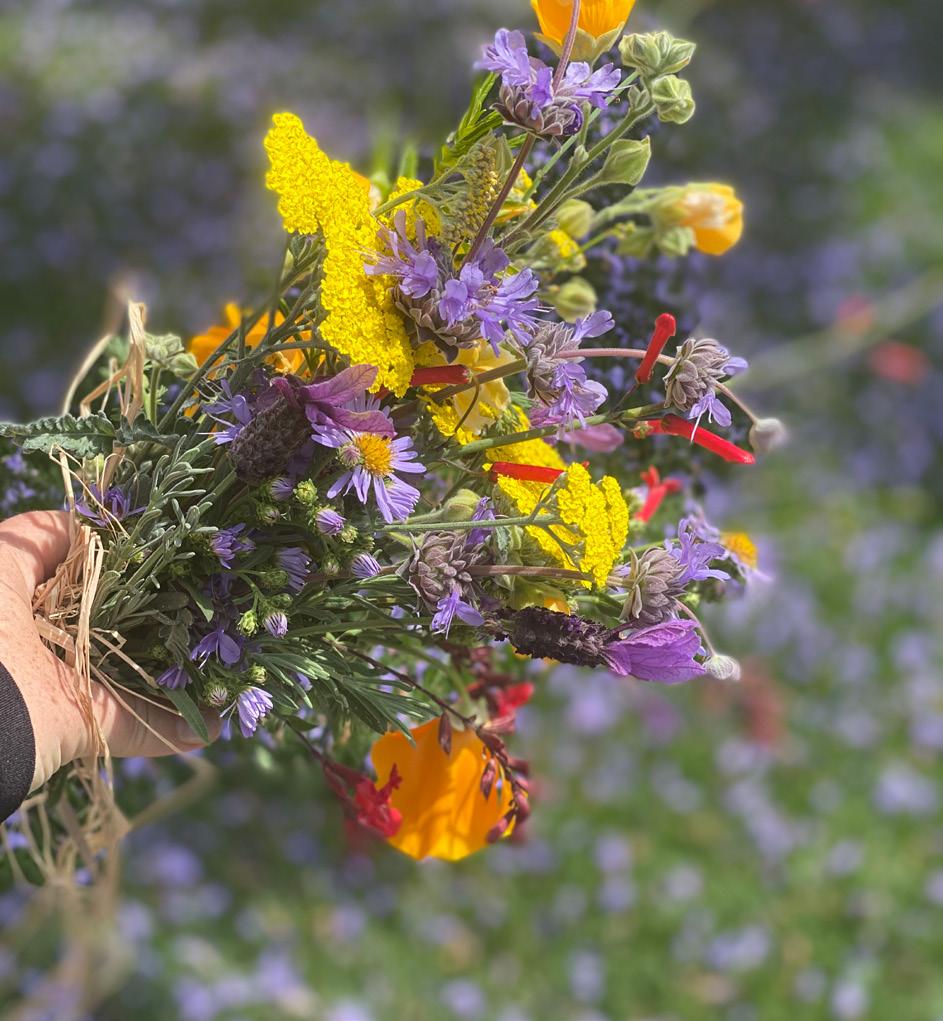
in Newport Beach had re-seeded and expanded into 15 hearty plants, teeming with monarch caterpillars. The wild coastal strawberry, asters and beach daisies sprawled across the front, and neon California poppies bloomed robustly in areas far from their original planting (poppies prefer to grow from seed). White sage mingled with lavender and rosemary, asters and salvia and goldenrod carpeted one side of the yard. The air hummed with bees. Sparrows, finches and warblers perched in the bushes. Living music. Blue-bellied lizards darted from the coyote bush and buckwheat and soaked up the heat of the concrete walkway. The air smelled like an ancestor of modern-day California.

I’m now entering my fifth spring, and I’m still adding plants and enjoying the many life forms that share this magical space with me. I have lots of visitors who tell me they can feel how alive the land is. I am still the only one on my street who has taken the less manicured, wild native route, and we definitely stand out in a neighborhood filled with geometric imported shrubs and stiff emerald lawns. I am confident, however, that this movement is catching momentum. I believe more and more people are realizing nature is not “out there” or separate from us. It’s right here at our front door, waiting for us to plant the seed.
For information on planting a native garden, to purchase plants and trees, or to join a workshop, visit Tree of Life Nursery at californianativeplants.com
Spring is here — it’s time to clean out your closet and refresh your wardrobe.
But before you ditch old trends and toss those skinny jeans in the trash, here’s a stat that may give you pause: According to the EPA, an estimated 11.3 million tons of textile waste ends up in landfills on a yearly basis in America alone. That nets out to roughly 81.5 pounds per person annually.
“We have perfectly good clothing and people are just trashing it,” says Sarah Lindenfelser, a San Clemente fitness instructor who is the co-founder of a new online resale boutique called Haute Legs.
Haute Legs was born from a series of personal setbacks. After losing her mother to cancer and developing an alcohol dependency that ended with a stay in the hospital, Sarah made a commitment to focusing on her health and following her passions — which included a lifelong dream of a career in fashion.

“I lost a bunch of weight from giving up the alcohol and I had a closet just full of clothes with tags on them,” she says. “Spending money on clothing was one of my vices and I realized it wasn't filling that void anymore.”
In April 2022, she began shopping her own closet to curate outfits that she sold on Instagram under the handle @haute_legs. “Used fashion is still cool, it’s still fun, it’s hip, and it looks great,” Sarah says. “I’m very passionate that money is not the answer; the brand label’s not the answer. Style is about being yourself.”
Timing for the launch of Haute Legs was ideal. Secondhand shopping surged during the pandemic. In fact, research cited by the U.S. Chamber of Commerce predicts that the resale market for clothing is anticipated to grow 16 times faster than non-resale over the next four years.
It’s a great fix for the fast fashion waste accumulating in landfills. And, there’s no better time than spring cleaning season to start decluttering — and shopping — consciously.
Nonprofits have long been worthy benefactors of closet cleanouts. Gently used clothing and accessories are sold at social enterprise thrift shops, with proceeds pouring back into the community in the form of critical programs and services that combat hunger, homelessness, joblessness, and more. In addition to nationally known nonprofits like Goodwill, Orange County is home to myriad independently run organizations that accept donations for resale, including local assistance leagues, Working Wardrobes, Laura’s House, and South County Outreach, among others.
Haute Legs also accepts closet cleanouts from the community, operating under a business model that ensures every item is sold, upcycled or given to a local nonprofit.
“The reason why we wanted to accept donations was to be able to give back,” says Haute Legs co-founder Vanessa Benavides. “Thirty percent of revenue from those donations go to our give partners. Every quarter we have a human give partner and an earth give partner.”
If clothing isn’t sold in 90 days, it’s donated to one of Haute Legs’ charitable partners or the textiles are brought to emerging fashion designers to be upcycled and repurposed, ensuring they won’t end up in a landfill. Later this year, the team says it will also be launching a pilot partnership for monthly clothing recycling with a city in Orange County, and has plans to roll out an app that will highlight the carbon footprint of every donation.
“When people donate within the system, they’ll be able to see it takes 1,800 gallons of water to make enough cotton for a pair of jeans,” says Vanessa. ”You can see that you just donated five pairs of jeans that equates to this much water saved. For me, it’s about the impact.”
And after you’re done decluttering, consider trading in your fast fashion for “slow” shopping — a sustainable approach rooted in buying with intention, shopping secondhand (especially local), and reusing materials to upcycle your wardrobe. The result? A curated closet full of favorites you’ll reach for and and can re-style with each wear.
When you’re ready to shop sustainable, here are four secondhand boutiques in Orange County making a difference for the planet, one outfit at a time.

Located in Laguna Hills, the Upscale Resale thrift store operated by South County Outreach benefits the nonprofit’s food insecurity and homelessness programs serving clients throughout Orange County. In addition to accepting donations, the shop sells gently used clothing, accessories, and jewelry in-store and on Ebay, offering everything from seasonal apparel to special occasion dresses. You’ll find a mix of brands here, from fast fashion staples such as Steve Madden to high-end designers like St. John Knits. sco-oc.org/thrift-store | IG: @upscaleresale_thriftstore

Also try: Hanger Boutiques by Working Wardrobes, Laura’s House Resale Store, RARE by Goodwill
Old Town Orange is an antique haven, so it’s no surprise you’ll find an array of authentic apparel and accessories dating as far back as the early 1900s in the retro city center. Whether you’re looking for vintage cocktail rings, a glam gown from the 1930s, or a 1950s-era terry cloth set, Elsewhere Vintage has a wide selection of highquality items. elsewherevintage.com
Also try: Joyride Vintage in Orange, Swellegant Vintage in Newport Beach

A Corona del Mar mainstay, the luxury boutique on East Coast Highway is a go-to spot for pre-loved designer wares. From shoe staples like Manolo Blahnik Hangisi pumps to coveted leather goods from Hermès, OnQue has everything a fashionista needs to step out in style. You can also bring in your own items to sell outright or on consignment, or trade it in for credit to shop the boutique’s well-stocked shelves. onquestyle.com | IG: @onquestyle
Also try: Bellissima Consignment Boutique in Corona del Mar, Twice the Style in Costa Mesa

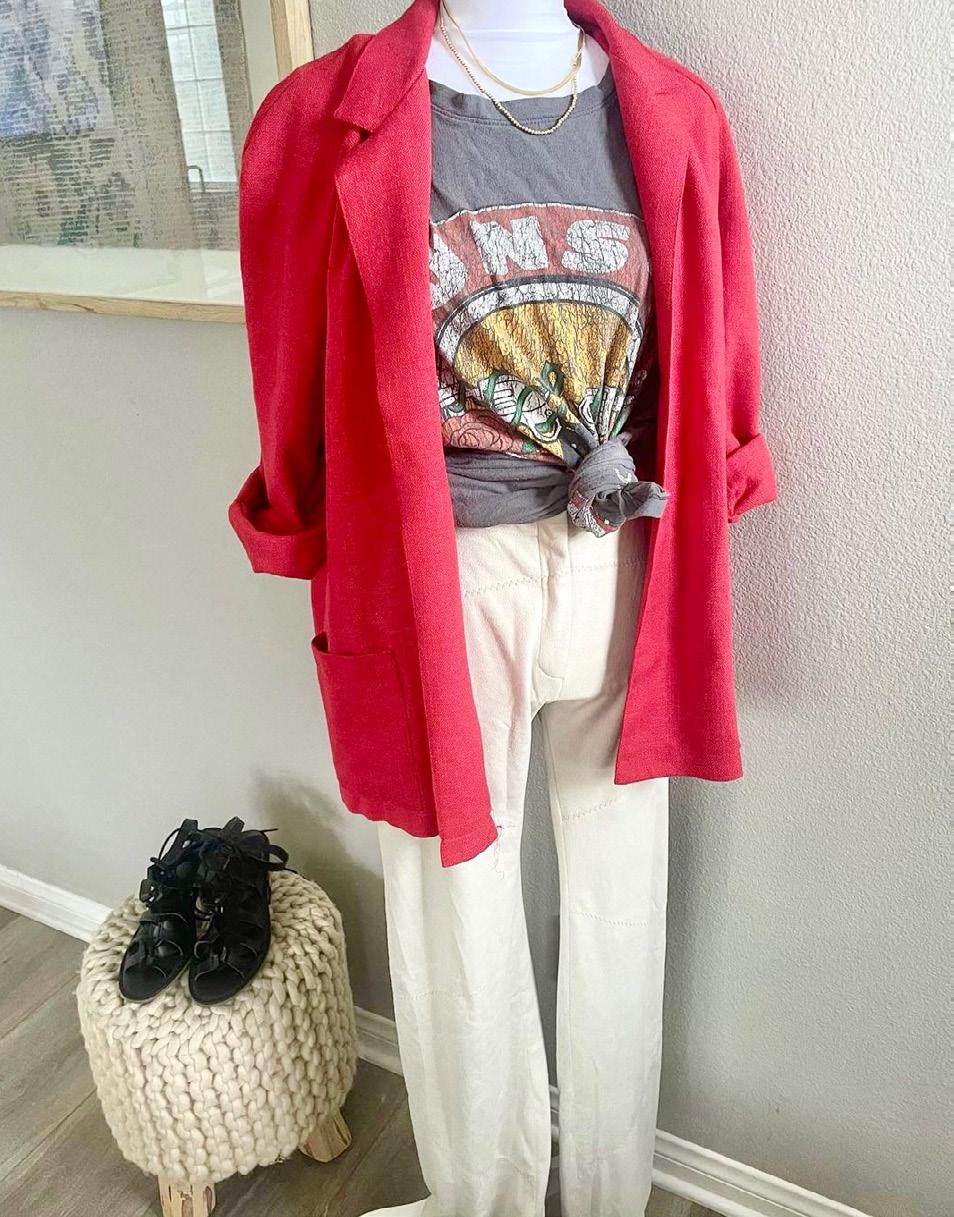
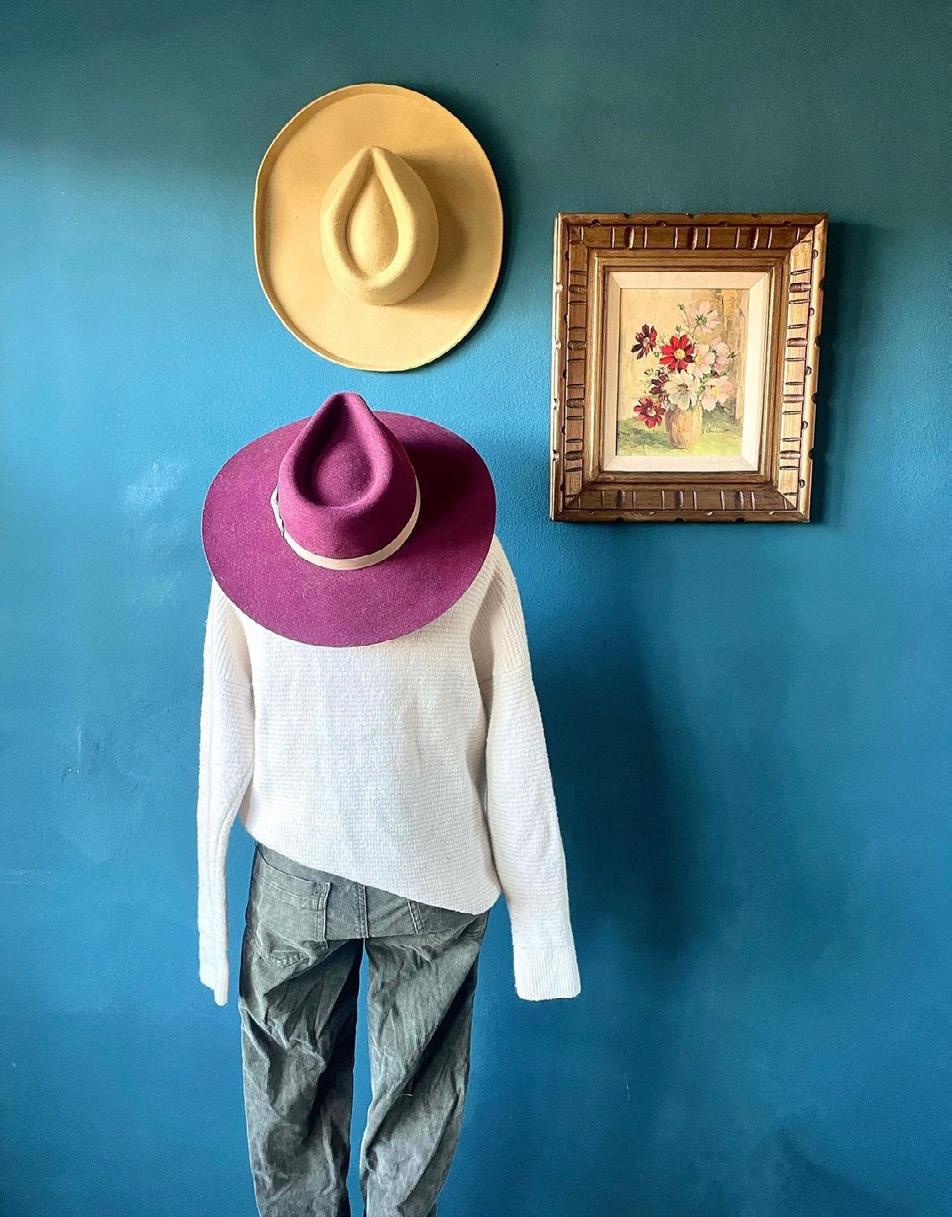
As an online boutique specializing in contemporary fashion for women, Haute Legs does the styling the legwork for its customers. On the shop’s Instagram profile, the team curates on-trend outfits using recycled pieces, creating looks that work for every style and occasion. Shoppers can DM the lot numbers to the team and purchase the entire look or shop on the new e-commerce platform launched last December. The company also hosts pop-up events with DIY upcycling demonstrations so shoppers can learn to add patches or embroidery to their own clothes. hautelegs.org | IG: @haute_legs
Also try: Dee Lux and Full Circle, both in Orange
Considering the recent drought, the wet winter that Southern California experienced this year was a welcome change — especially for residents and visitors looking for wildflowers.
The potential for a “super bloom” in 2023 has local flower fans excited, but it’s still too early to tell if it will live up to the name. Even if the local blossoms don’t reach full-blown super bloom level, experts are anticipating an above-average bloom as flowers have been popping up across the region since January.
In anticipation of a flowery season, we’ve got your guide to the best locations for seeing blooms across Southern California, plus top tips for responsible recreation.

For an easy way to stay up to date on what locals are seeing in natural areas, check out the Facebook group California Wildflower Report, where members post photos and details of flowers found across the state. The California Department of Parks and Recreation also has a “Wildflower Bloom” page for the 2023 season that is continually updated.
As of mid-February, California’s desert state parks are cautiously optimistic in expecting a “good” to “better than average” wildflower bloom this spring. Recent weather and temperature shifts may help or hinder the expansive wildflower spread.
You can also call into a free wildflower hotline, managed by the Theodore Payne Foundation for Wild Flowers & Native Plants. Starting March 3, hear weekly recorded wildflower reports narrated by Emmy Award-winning actor Joe Spano by dialing 818-768-1802, extension 7. All locations are on easily accessible public lands and range from urban to wild. New reports are released every Friday from through May.
For desert-specific blooms, a great resource to check is desertusa.com. Readers send in reports with location information and photos throughout the wildflower season for California as well as deserts in other states.
There are also a number of local events and programs for those who might want some guidance outdoors.
In Orange County, the Irvine Ranch Conservancy offers activities including a Beautiful Botany course, as well as free wildflower field guides on its website letsgooutside.org. All the activities have some sort of interpretive component where the lead volunteer or docent provides information about the land, explains Irvine Ranch Conservancy communications manager Scott Graves.
Other organizations offering local programs include OC Parks (ocparks.com/events) and the Laguna Canyon Foundation (lagunacanyon.org), which native plant hikes led by volunteer naturalists.
Near Southern California, you’ll likely find a variety of colors, shapes and sizes depending on the environment. In the drier regions, expect to see desert dandelions and lilies, desert sand verbena, and colorful blooms on prickly pear and cholla cacti.
Scott says Orange County visitors are likely to see arroyo lupine and the California poppy, which is blooming across Irvine Ranch landmarks. Other flowers that might be spotted include red maids, fiddleneck, blue dicks, coastal paintbrush, wild cucumber, popcorn flower and golden violets.

Laguna Canyon Foundation officials note that around the coastal areas, visitors may also see school bells, splendid mariposa lily, chapparal sweet pea, Catalina mariposa lily, buckwheat flowers and shooting stars.
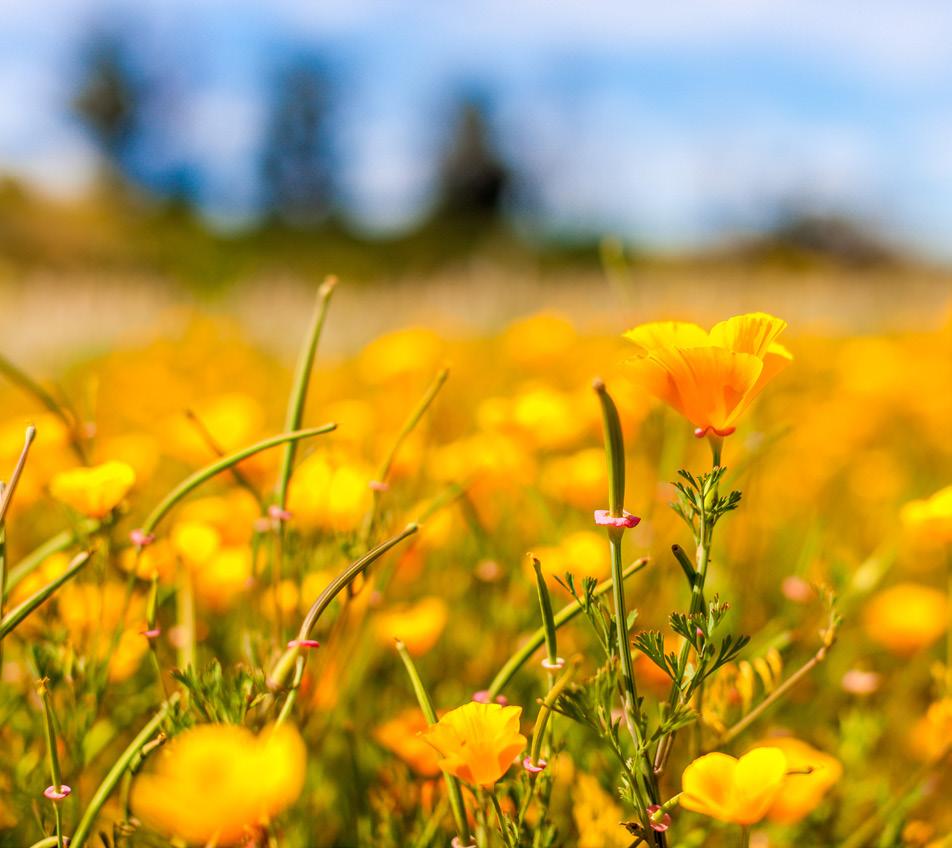
No matter how tempting it might be to skip through the flower fields, pluck a blossom or take a photo resting on a bed of blooms — don’t do it. Park and land officials emphasize how important it is for visitors to recreate responsibly.
“The most important thing people can do to is stay on the trail,” Scott says. “Going off-trail can damage native plants and wildlife. It is fine to get up close with your phone or camera, as long as you are staying on the trail.”
Remaining on the designated trail means no shortcutting, no trampling vegetation, and definitely no sitting or lying on the fragile flowers. To get eyecatching images of yourself “in” the flowers without stepping on the beautiful blossoms, try using a longer lens to make the background appear closer.
“If the state is lucky to be adorned with wildflower blooms this spring, we want to make sure that everyone has a positive experience when exploring them,” says California Department of Parks and Recreation Director Armando Quintero. “California State Parks welcomes all to enjoy these unpredictable, rare occurrences but asks visitors to ‘Don’t Doom the Bloom’ by staying on designated trails and taking only photos, not flowers.”
“Nature is meant to be enjoyed, not tampered with, and
taking items from the park can impact the natural habitat,” agrees Whiting Ranch Wilderness Park supervising ranger Candi Hubert. “Leaving flowers alone ensures others can enjoy them as much as you did.”

In the interest of safety and conservation, visitors are also asked to understand the area they plan on visiting, check the weather, respect the landscapes and know their body limitations, Armando adds.
The best time to see wildflowers blooming in Southern California is mid-February to mid-May. But conditions change quickly, so check the location’s website and wildflower reports regularly. For example, some trails get closed due to heavy rain, so check before heading out to ensure you have the latest information and are aware of the regulations. Not adhering to these regulations can force officials to take more dramatic action, which happened in Lake Elsinore this February with the closure of Walker Canyon trails, access street and nearby parking areas. As explained in the press release, it’s a proactive measure to ensure the safety of residents, visitors and the environment. It comes as no surprise after thousands of people flocked to Walker Canyon over the course of a few months in spring 2019. As the super bloom spread over 1,600 acres of hillsides, it also spread over social media. And as an example of what not to do, some spectators ignored rangers and signage and walked off the established trail, sat and stood on the flowers, and left trash on the ground.
Photos courtesy of Sara Hall 30At Whiting Ranch Wilderness Park in Foothill Ranch, hikers can see wildflowers along the Borrego Canyon Trail to Red Rock Canyon. The colorful sandstone canyon has one of the most interesting landscapes in the region, with more similarities to Arizona or Utah than typical Orange County geography.
For those up for a more strenuous hike, Candi says that patches of poppies can be seen at higher points in the park, like the top of Dreaded Hill, Water Tank and Vulture View Roads. There, flowers are growing on south-facing slopes for viewing at a distance. She also reminded visitors to pack plenty of water and wear sturdy footwear and sun protection, as viewing wildflowers at Whiting Ranch Wilderness Park requires a good deal of hiking.
Another great local spot to find wildflowers is Laguna Coast Wilderness Park. With more than 40 miles of hiking trails throughout the 7,000-acre park, visitors have plenty to explore while searching for blossoming vegetation.
If you’re looking for a challenging hike or an interesting trail with wildflower opportunities, there are several local options for hiking enthusiasts.
Chino Hills State Park is well-known for its flowering hills and trails that are home to California poppies, wild mustard, canterbury and school bells, arroyo lupine, and more. The best wildflower viewing experiences are on Bane Ridge Trail, but flowers can be found throughout the large network of trails, including the Telegraph Canyon, Sycamore and Aliso Canyon trails. Watch your footing as it is also rattlesnake season.
Another great option for hikers on the hunt for wildflowers is Santiago Oaks Regional Park. Try out Santiago Creek, Barham Ridge and Weir Canyon trails for some flowery outdoor fun. You’ll likely see poppies, arroyo lupine, wild mustard, fiddleneck, and more.

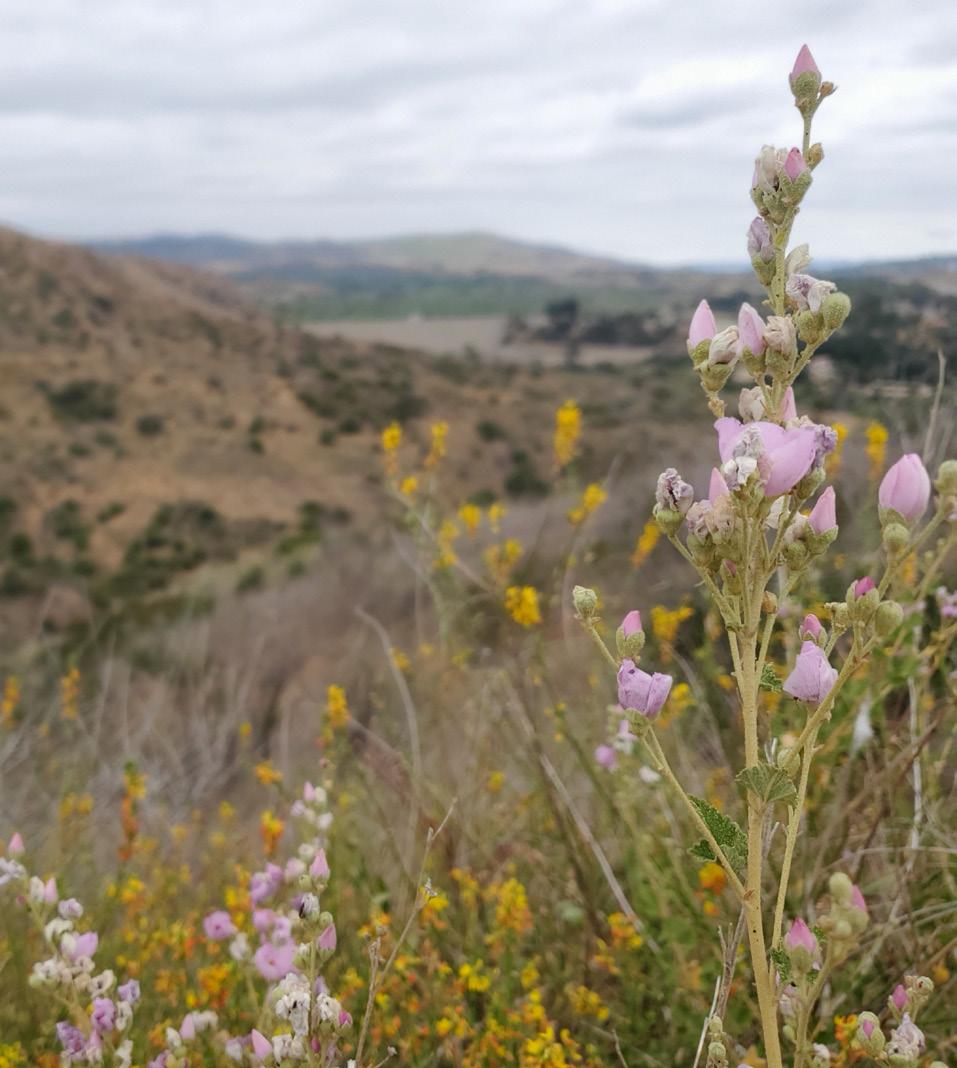
The Mojave and Sonoran deserts border Southern California, and it’s a special treat when wildflowers start blooming in the arid environment. Nature lovers can visit a state or national park for the best opportunities.
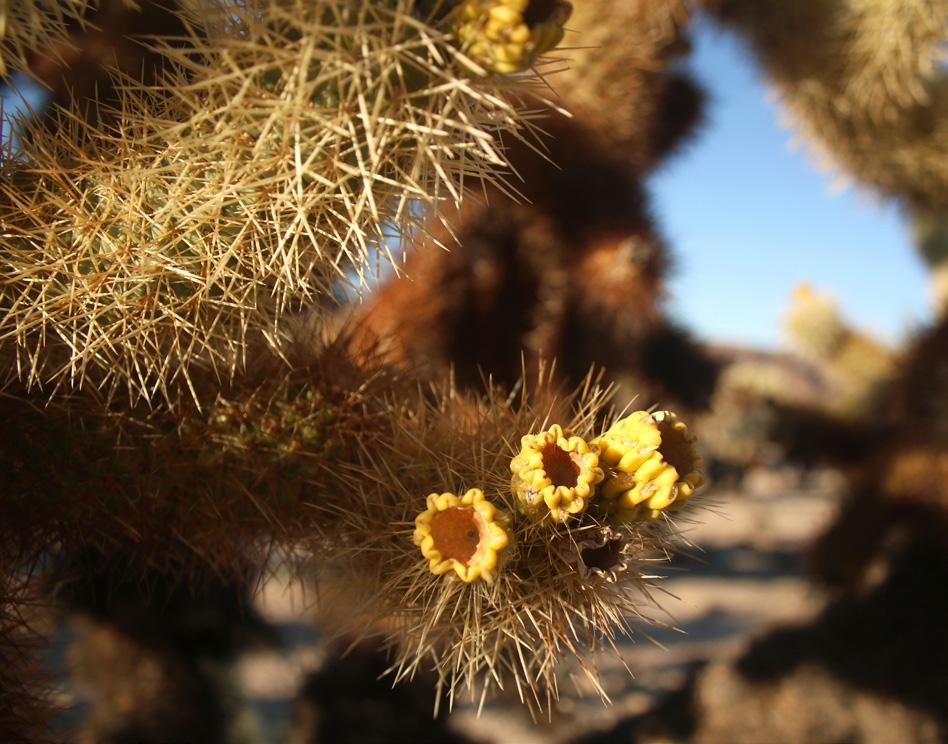
The dry landscape of California’s largest state park, Anza-Borrego, comes to life for a short period of time each spring. And if the early bloom in December is any indication of what is to come, this year’s displays could be phenomenal, officials wrote on the website. Visitors can see remaining sand verbena and desert sunflowers along the east side of Henderson Canyon Road in the northern end of the park and sand verbena at June Wash along State Route 2 in the southern end of the park. There’s also a wildflower hotline that provides up-to-the minute information at 760-7674684 and a regular bloom report on the Anza Borrego Foundation website, borregowildflowers.com.
Just north of Anza-Borrego is Joshua Tree National Park featuring 1,200 square miles of impressive desert landscape.
There you’ll find mariposa and desert lilies, Mojave poppies, canterbury bells, desert dandelions, and
more. Wildflowers may begin blooming in the lower elevations of the Pinto Basin and along the park’s south boundary in February and at higher elevations in March and April. Desert regions above 5,000 feet may have plants blooming as late as June.
Finding flowers blooming in the desert is tricky and the conditions need to be just right, so be sure to check the park’s websites and social media at parks.ca.gov/?page_id=638 and nps.gov/jotr.

For nature lovers who want to get outdoors without venturing too far from the city, there are several trails hidden in urban Orange County that feature wildflowers. Scott recommends people visit one of Irvine Ranch Conservancy’s self-guided access areas — try Bommer Meadow and Nature Loop trails at Bommer Canyon in Irvine, or Bobcat Trail in Buck Gully Reserve in Newport Beach.
Bommer Canyon is a hidden gem, with greenery and wild mustard covering the hills in spring. Kids will love the meandering trail in the canyon, home to one of the region’s last working cattle camps.

At Buck Gully, the 254-acre reserve is small, but packs a punch. The single trail follows a creek in a wooded area, tucked away between busy neighborhoods. On the outskirts of a town is the Azusa River Wilderness Park. Situated at the gateway to the San Gabriel Mountains, a gentle trail follows the San Gabriel River along the canyon. In spring, you might see sunflowers, golden yarrow, scarlet larkspur, yucca and globe gilia.
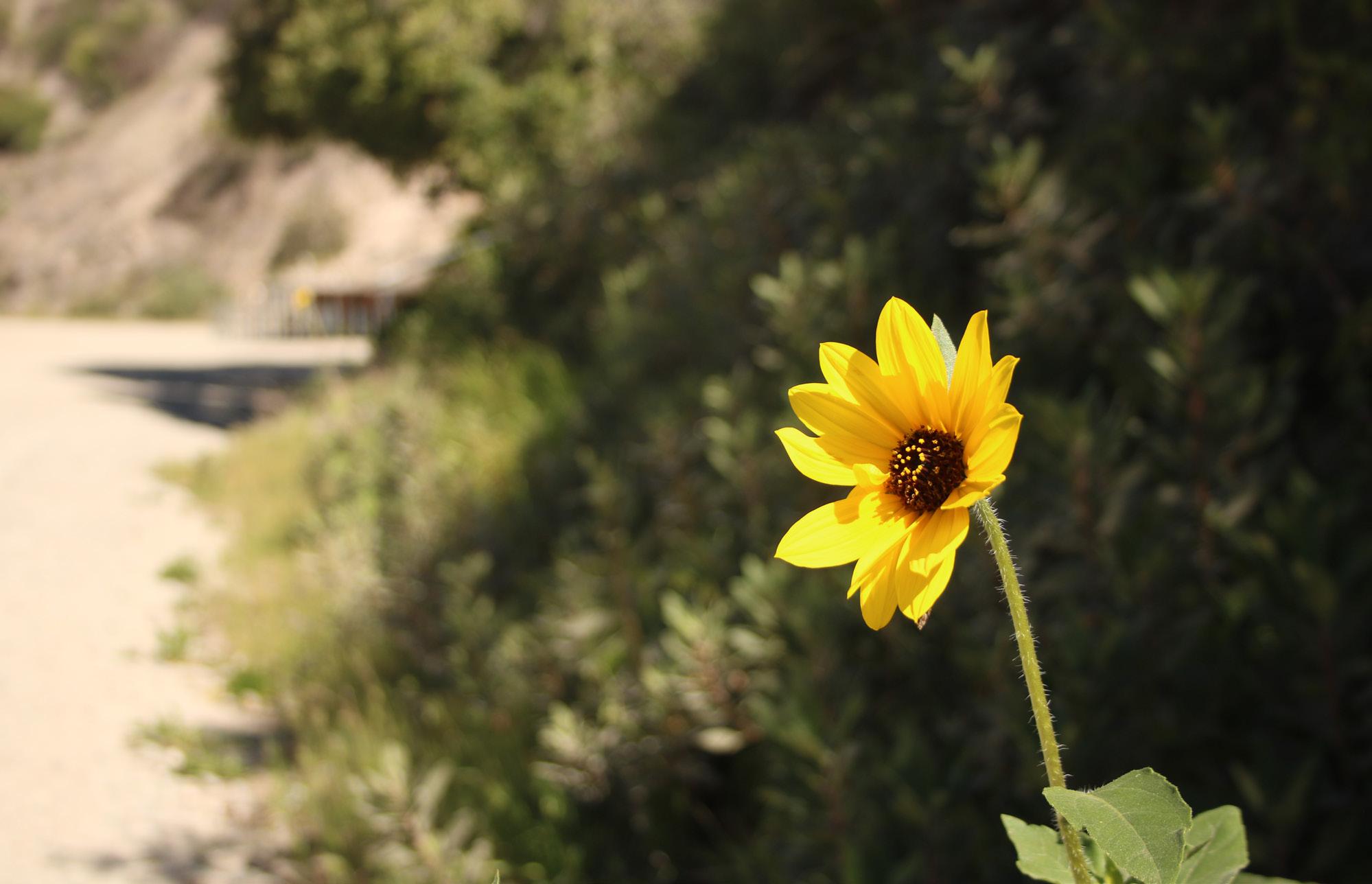
There’s no shortage of flowering coastal environs in Southern California. Locally, check out Crystal Cove State Park or Dana Point Headlands; at both locations, trails along the beach, canyon or bluffs should have wildflowers, including bush sunflowers. Find lupines and wild mustard at Crystal Cove, or California buckwheat, prostrate spine flower and seaside redmaids in Dana Point.
Further up the coastline, Malibu is also a popular spot for wildflower viewing. Nature lovers can visit Malibu Bluffs Park Open Space, Malibu Creek State Park, Point Mugu State Park or Point Dume for the best opportunities. Expect to see tickseed, bush flowers, California poppies, sand verbenas and evening primrose.
If you’re feeling up to a boat ride, search for wildflowers at Channel Islands National Park, which is home to more than 800 plant species. According to park officials, each island is floristically unique due to a complex interplay of factors, including distance from the mainland and other islands, size of the island, local climate, maximum elevation, and topographic diversity.
On the islands, you can find yellow tickseed, three varieties of paintbrush (including the rare island paintbrush and the even rarer soft-leaved paintbrush), tree sunflowers, white mallow, and island gilia (another rare and fragile flower). Some of the wildflowers are only found on certain islands, so be sure to do your research before heading out.

You can also see wildflowers on Catalina Island (not part of the national park) by booking a bus or Jeep tour of the inland wildlands or hiking along the challenging Trans-Catalina Trail. The island is home to bush sunflowers, poppies, hyacinth, lupine, paintbrush flowers and more.
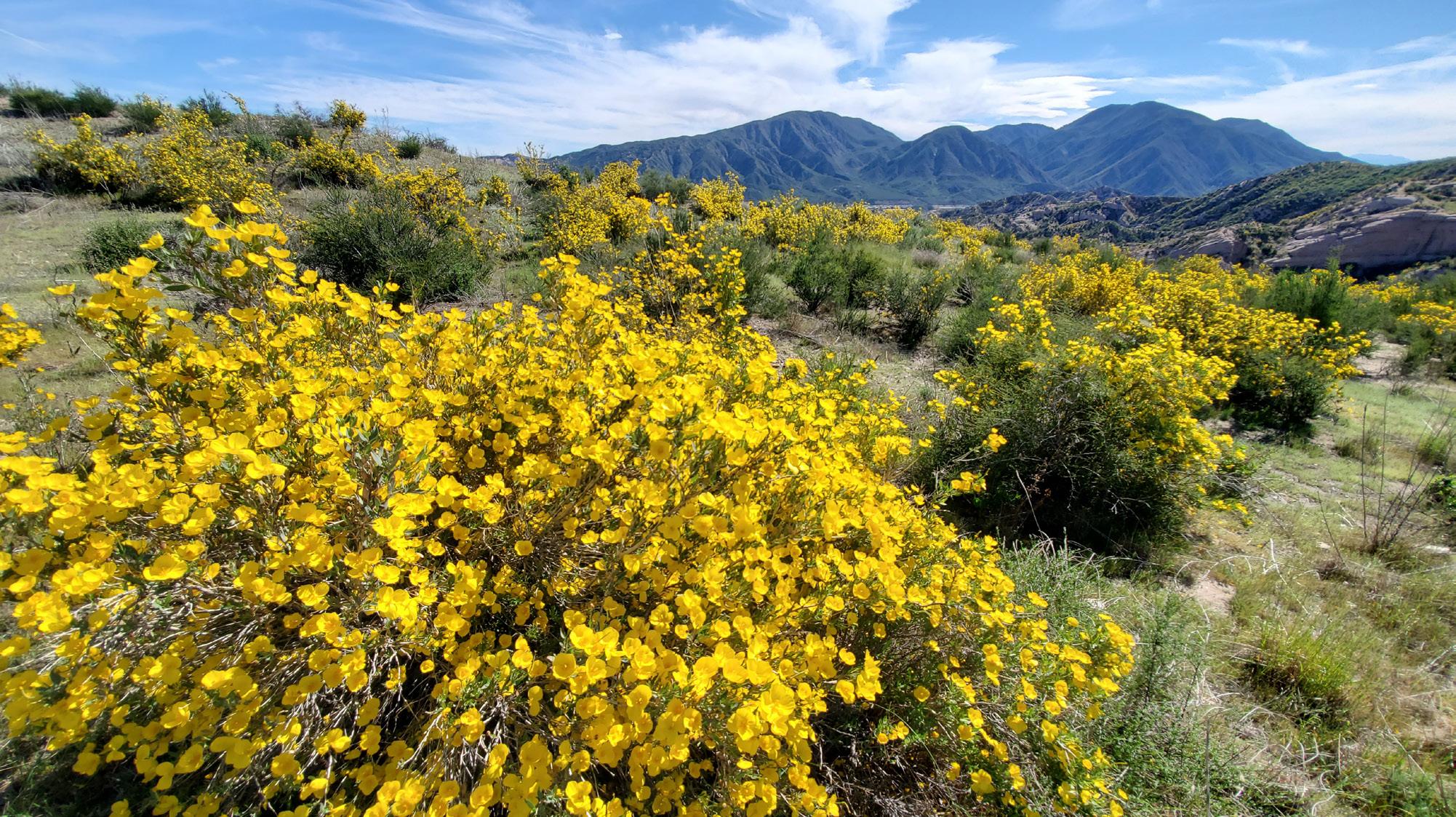
If you have the time, there are several incredible spots for wildflowers within driving distance.
Antelope Valley California Poppy Reserve is an intense mosaic of colors and scents during the wildflower season. The reserve has 8 miles of trails, including a paved section for wheelchair access. The dominant flower blanketing the hills is the California poppy, but there are also forget-me-nots and fiddlenecks sprinkled into the mix. It also happens to be the most consistent poppy-bearing land in the state.
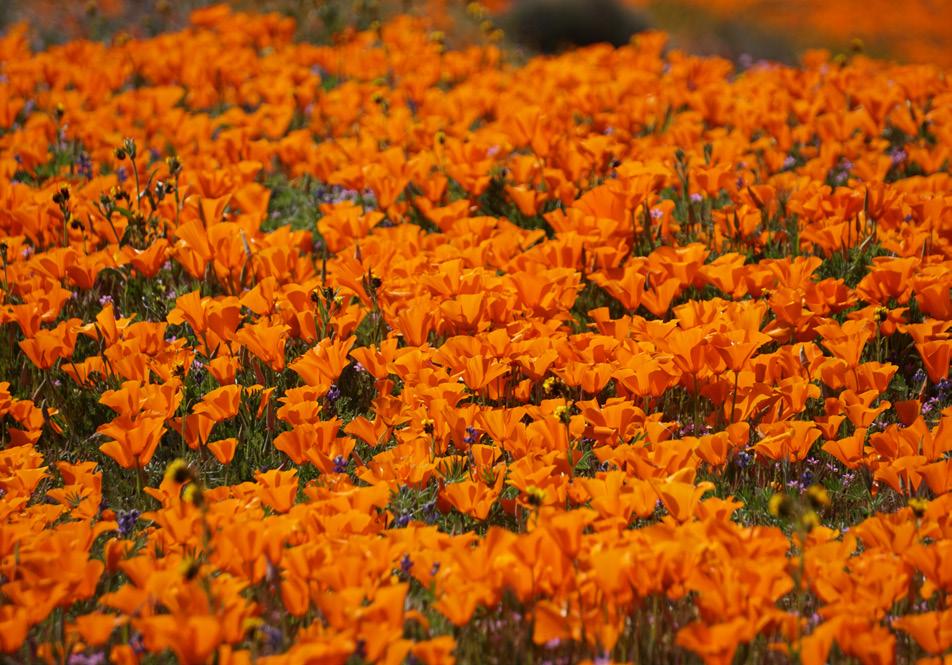
Just a few hours further north is Carrizo Plain National Monument in the central valley, the largest remaining native grassland in California. The Bureau of Land Management governs the area, which is arguably the best kept wildflower secret in the state. Carpeting the valley floor are California goldfields, wild scorpionweed and fiddlenecks.
Whether you’re looking for an easy walk or challenging trek in the hills, beach or desert, you’re bound to have some flower fun this spring. Just keep best practices for viewing in mind and you’ll be set to explore all the wildflowers that Southern California’s top parks and open spaces have to offer.
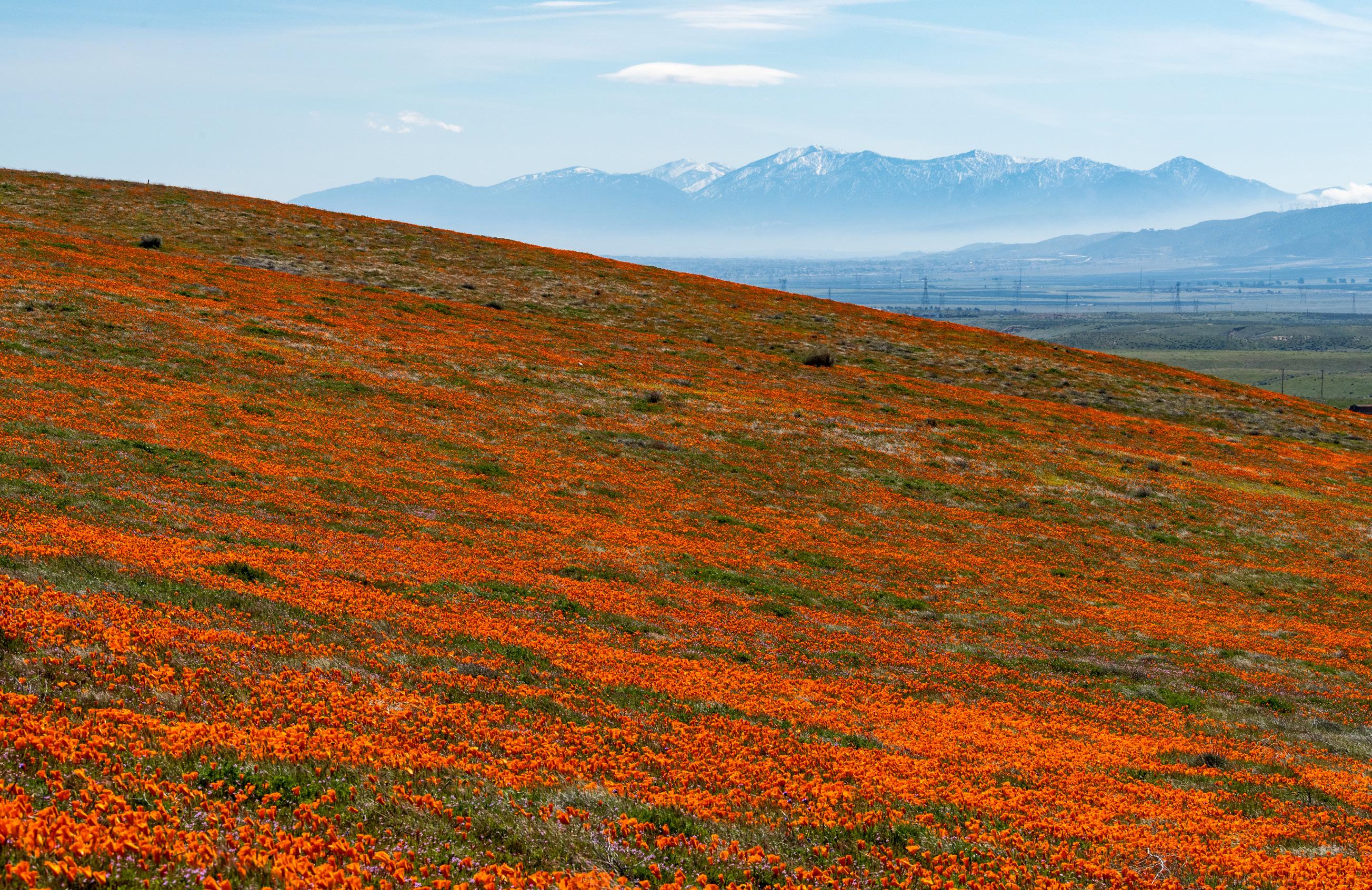
I have a confession to make: I am a junkie. To be clear, my drug of choice is not a drug at all — it happens to be personal growth. I started more than 20 years ago, and once I opened that Pandora's box, I haven’t been able to stop. And the funny thing? I am learning more about myself now at the age of 57 than I ever have.

The thing about the growth journey is that there is no finish line. You will never hear anyone say “That’s it! My work here is complete. I know everything I need to know about myself and life in general.” (And if you do? Run for the hills!)
It doesn’t work like that. Just as you start peeling back the layers, you discover new things about yourself. And it makes sense, right? We are living, breathing, evolving beings. Life is not static, and neither are we. As our life circumstances change, we adapt. Or not.
So, what’s so great about personal growth? For me, it is key to creating a life you love. Simply look at Maslow’s hierarchy of needs for a clue.
Yes, we must meet the basics for our physiological (shelter, food, water) and safety (personal security, resources, health) needs. But what happens beyond that? It isn’t until you start to ascend the higher tiers of the pyramid that you get a glimpse of what it truly means to live.
Achieving your full potential through self-actualization — and discovering true meaning in your life — is where the magic happens. The highest tier is where purpose and passion and joy live. It’s where you start living your life instead of your life living you.
But how do you do that? Where do you start?
It all starts with one person: you.
If that makes your palms start to sweat a little bit, read on. That means we’re on the right track!
Maybe at this point you are asking yourself, “If this is so great, why isn’t everyone happily living their best life?” The answer is because initiating this type of growth isn’t easy. Oftentimes, as it did for me, it comes from a major life transition or existential crisis. And let’s face it — those by their very nature aren’t a day at the beach.
This journey takes courage in the face of the fear and resistance that will inevitably arise. That’s the only way you are going to get out of your comfort zone (the lower portion of Maslow’s hierarchy where basic needs are met), to start your ascent to something greater.
Fear and resistance are persistent and the masters of disguise. They may manifest as that little voice that says, “Aren’t you being selfish taking this time for you?” Or the doubt you feel after your friend rolled her eyes when you told her about signing up for that painting class.
Don’t let fear stop you. While it may keep you safe when you’re in an unfamiliar city, for example, when it comes to personal growth, safe equals stuck.
For those of you who are just getting started, these tips may be helpful as you begin your journey.
• Practice self-inquiry. It’s a big part of discovering who you are and what’s important to you. Schedule 10 to 30 minutes a day for quiet reflection time. This can be on your morning walk (no AirPods!) or sitting with your coffee in your backyard. Ask yourself some of the following questions: What do I like to do? What am I passionate about? What do I want my life to feel like? Then record everything that comes up — don’t edit! Write it down in your journal or use voice notes on your phone.
• Adopt a growth mindset. Think about your life from a place of possibility. Forget about what you know — or think you know — about who you are and what you are capable of.

• Get curious. Over time, you may start to notice a picture forming from your inquiry practice. Maybe you feel the pull of something creative or that you really want to make an impact in the world. Pull that thread — what type of art are you drawn to? Are there classes close by you can sign up for? What charitable causes light you up or make you emotional? Then start researching ways to scratch that itch.
• Pay attention. When you’re out in the world, start noticing what you are drawn to. What excites you. What scares you just a little bit. Then lean in.
• Commit to yourself. Set boundaries by choosing to spend time with those who support your quest for growth. Avoid the naysayers. Oftentimes, they may be resistant because your journey brings up their own desire for creating a life they love and the fear that comes along with it.
This process isn’t always easy, but nothing worth having is. It can be incredibly rewarding and inspiring as well as difficult and painful. But that’s the point. Truly living is about feeling it all.
I can honestly say that I look at my life as “before” and “after.” My life today since I embarked on this journey is better than I could have ever imagined all those years ago, and the best part? It just keeps getting better and better. It’s never too early or too late to start. So, what are you waiting for? Your life is waiting for you!
available at Molly Wood Garden Design and via KarlinMeehanStudios.com
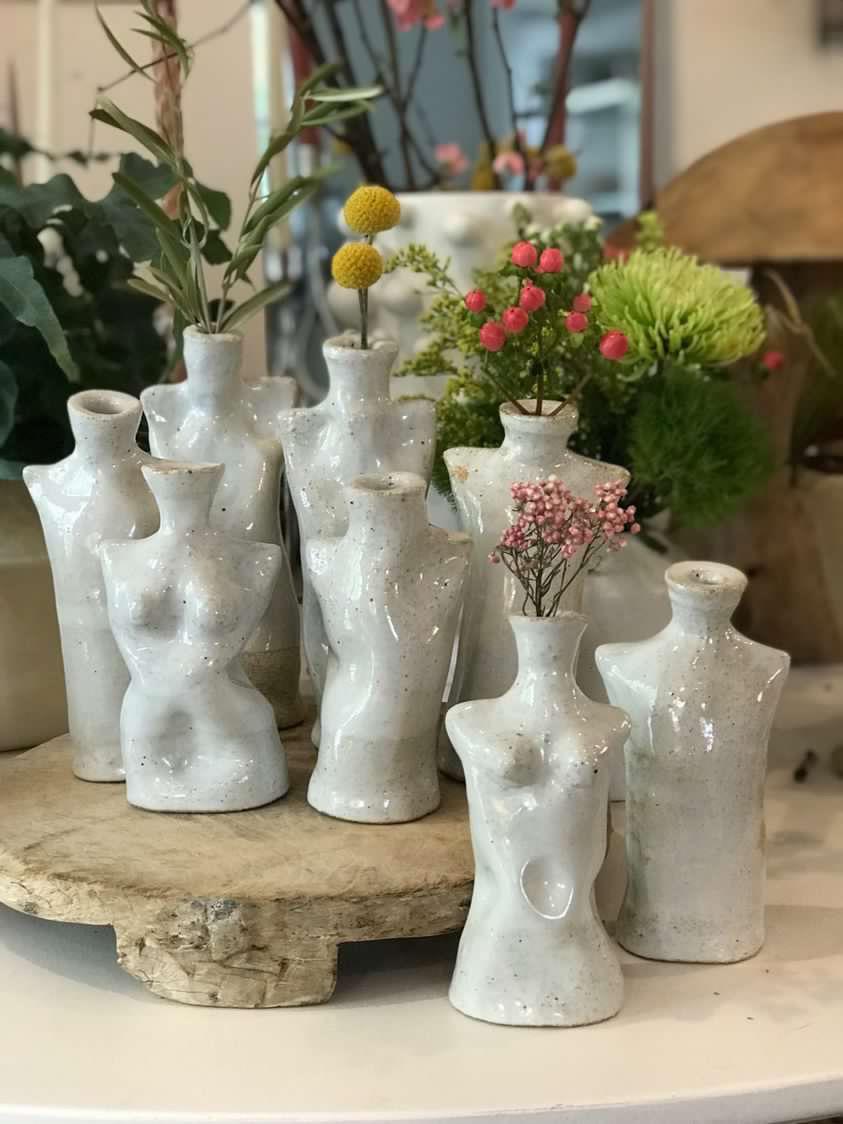 Statue vases by artist Karlin Meehan organic forms hand-shaped in clay
Statue vases by artist Karlin Meehan organic forms hand-shaped in clay